Annual Report on Official Languages for Fiscal Year 2017 to 2018
The Official Languages Act (the act) requires that the President of the Treasury Board report to Parliament on the status of official languages programs in federal institutions subject to Parts IV, V and VI of the act.
On this page
- Message from the President of the Treasury Board
- Introduction
- Communications with and services to the public
- Language of work
- Participation of English-speaking and French-speaking Canadians
- Human resources management
- Governance
- Monitoring
- Conclusion and trends
- Appendix A: Methodology for reporting on the status of official languages programs
- Appendix B: Federal institutions required to submit a review for fiscal year 2017 to 2018
- Appendix C: Definitions
- Appendix D: Statistical tables
Message from the President of the Treasury Board

President of the Treasury Board and Minister of Digital Government
The year 2019 marks the 50th anniversary of the Official Languages Act, and the Prime Minister has committed to modernizing Canada’s flagship language legislation. This puts us at a critical juncture in the history of Canada’s linguistic duality.
I am pleased to present the 30th annual report on official languages.This report sets out the government’s efforts to promote the equal status of English and French in Canada and in the federal government. The Official Languages Act is the legislation that provides for bilingual communications and services for Canadians, recognizes English and French as the languages of work in federal institutions, and ensures equitable participation of English-speaking and French-speaking Canadians in the public service.
The government has undertaken a review of the Official Languages (Communications with and Services to the Public) Regulations, which were adopted in 1991. This review will lead to changes that better reflect the diversity and vitality of our official language minority communities. To inform our review, we reached out to the public and to stakeholders so that we could hear from them about how we could shape the future for services provided in our official languages, by better anticipating the language preferences of Canadians, by taking into consideration the vitality of communities, by taking into account linguistic duality nationally and internationally, and by using technology. I would like to thank everyone who took part in the extensive public consultations, particularly the Experts Advisory Group, representatives of official language minority communities, and Canadians from across the country who took the time to respond to our online questionnaire.
The government is also moving forward on recommendations in the report The Next Level: Normalizing a Culture of Inclusive Linguistic Duality in the Federal Public Service Workplace, submitted to the Clerk of the Privy Council in September 2017, to make the work environment more conducive to the use of both official languages. This includes working toward the creation of a modern and inclusive official languages framework that comprises a plan for an efficient and flexible language-learning continuum. This continuum will, on the one hand, support federal institutions in determining the competencies they need to meet their official languages obligations and, on the other hand, reinforce and promote second-language learning, assessment, practice and maintenance among public servants. The results of the 2017 Public Service Employee Survey are revealing, and while much work remains to be done, we are encouraged by some progress in workplace bilingualism.
We can be proud of the progress achieved, but we must seize opportunities to keep our legislative and regulatory frameworks current, while continuing to promote a workplace that welcomes the use of both official languages.
I invite you to read this report and to learn about the scope of the Government of Canada’s efforts to sustain and enhance Canada’s linguistic duality.
Original signed by
The Honourable Joyce Murray
President of the Treasury Board and Minister of Digital Government
Introduction
The history of Canada is rooted in our country’s two official languages, English and French. They are at the heart of our identity and enhance our image and place in the world. They open up a host of opportunities and hold many social, economic and cultural benefits, both individually and collectively.
The Official Languages Bill is a reflection of the nature of this country as a whole, and of a conscious choice we are making about our future.
The passage of section 133 of the British North America Act in 1867 made English and French the official languages of Canada. In 1969, the Government of Canada passed the Official Languages Act (the act) in the wake of the recommendations of the Royal Commission on Bilingualism and Biculturalism. This first version of the act set out that “English and French are the official languages of Canada for all purposes of the Parliament and Government of Canada” and “possess and enjoy equality of status and equal rights and privileges as to their use in all institutions of the Parliament and Government of Canada.”
The 1969 act extended the constitutional guarantee regarding the use of English and French in Parliament and federal courts to all federal institutions, including departments, agencies and Crown corporations, as well as quasi-judicial and administrative bodies. It also established, for the very first time, a person’s right to receive federal services in English or in French. It also created the Office of the Commissioner of Official Languages to receive and investigate complaints from the public, make recommendations and report to Parliament.
In 1988, the act was repealed and replaced by a new one with significant changes as a result of the 1982 Canadian Charter of Rights and Freedoms. The Charter enshrines in the Constitution the principle of equality of English and French as to their use in all institutions of the Parliament and Government of Canada and sets out the public’s right to communicate with and receive services from federal institutions in English or in French.
I believe that we have the essential ingredients necessary to give effect to the constitutional rights of Canadians regarding official languages, be they members of the public served by federal institutions or employees of these institutions. The new Official Languages Act is now in place. An atmosphere of renewal is growing in federal institutions as a whole, and a fair and equitable approach to language management has been developed.
The 1988 act, the quasi-constitutional status of which has since been recognized by the courts, defined more specifically the public’s right to communicate with and obtain services from federal institutions in the official language of their choice when justified by the nature of the office or where there is significant demand for communications and services in that language. For the first time, the Official Languages Act gave employees of federal institutions the right to use either official language, in accordance with the provisions of Part V of the act, which covers the language of work in federal institutions.
More recently, with the implementation of the Public Service Modernization Act, deputy heads were given primary responsibility for human resources management in their organization. It is their role to ensure that their institution:
- develops and maintains a corporate culture that is conducive to the use of both official languages
- has the capacity to communicate with the Canadian public and with public servants in both official languages
- maintains a public service workforce that tends to reflect the two official language communities
The Treasury Board is responsible for the general direction and coordination of the policies and programs relating to the implementation of Parts IV, V and VI of the act in all federal institutions. The Office of the Chief Human Resources Officer (OCHRO), within the Treasury Board of Canada Secretariat, is responsible for developing and evaluating those policies and programs.
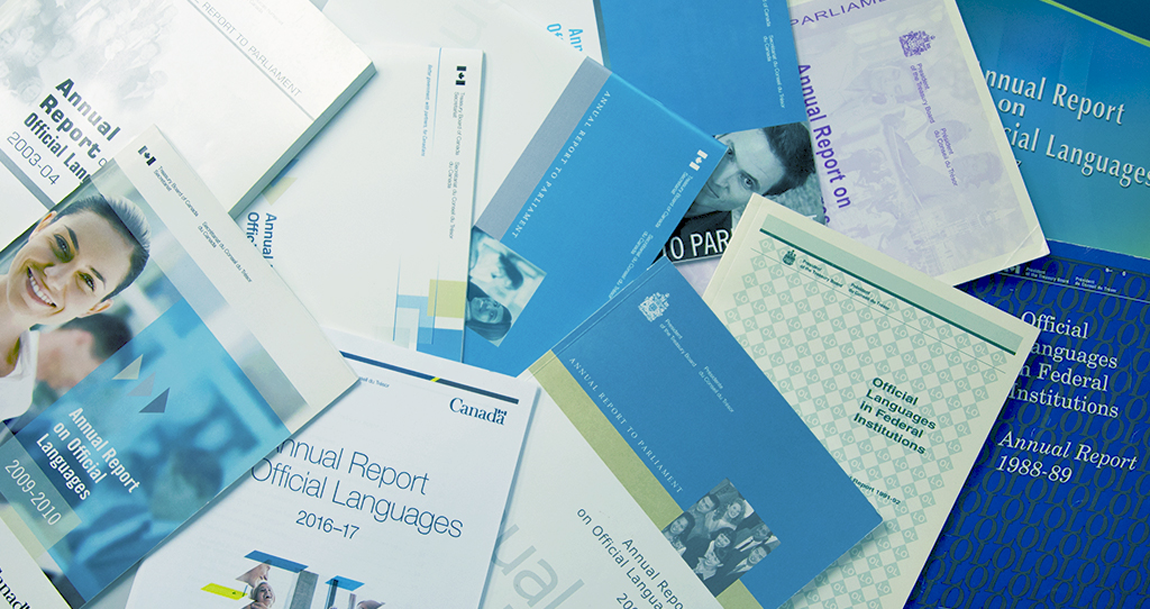
The act requires that the President of the Treasury Board report to Parliament on the status of official languages programs in some 200 federal institutions, including departments, agencies and some privatized organizations. This 30th annual report outlines the activities and accomplishments of federal institutions in meeting their official languages responsibilities for the 2017 to 2018 fiscal year.Footnote 1 OCHRO compiled it using reports submitted by institutions, as well as data extracted from information systems. The methodology for reporting on the status of official languages programs is explained in Appendix A.
Communications with and services to the public
The network of offices and public service locations of federal institutions is vast. It covers the entire country, all provinces and all territories, and even extends abroad. It includes counter service, interactive kiosks, commemorative plaques, toll-free telephone lines, as well as air, ferry and train routes.
Enacted in December 1991, the Official Languages (Communications with and Services to the Public) Regulations (the regulations) give substance to Part IV of the act by specifying the circumstances in which the offices of federal institutions have a duty to offer services and communications in both official languages. A concrete and detailed instrument for implementing certain Charter concepts and certain provisions of Part IV of the act, the regulations define the concepts of “significant demand” and “nature of the office.”
The Official Languages Program took a significant step forward on December 16, 1991, when the government approved Regulations on service to the public. With these Regulations, over 90% of Canadians from the two official languages communities will have access to federal government services in the language of their choice.
In November 2015, the government committed to ensuring that “all federal services are delivered in full compliance with the Official Languages Act.” The review of the regulations is part of the government’s commitment to official languages. Following a November 2016 announcement that the regulations would be reviewed, OCHRO reached out to key stakeholders, such as representatives of official language minority community organizations, the Office of the Commissioner of Official Languages, as well as provincial and territorial governments that deliver services in the minority official language.
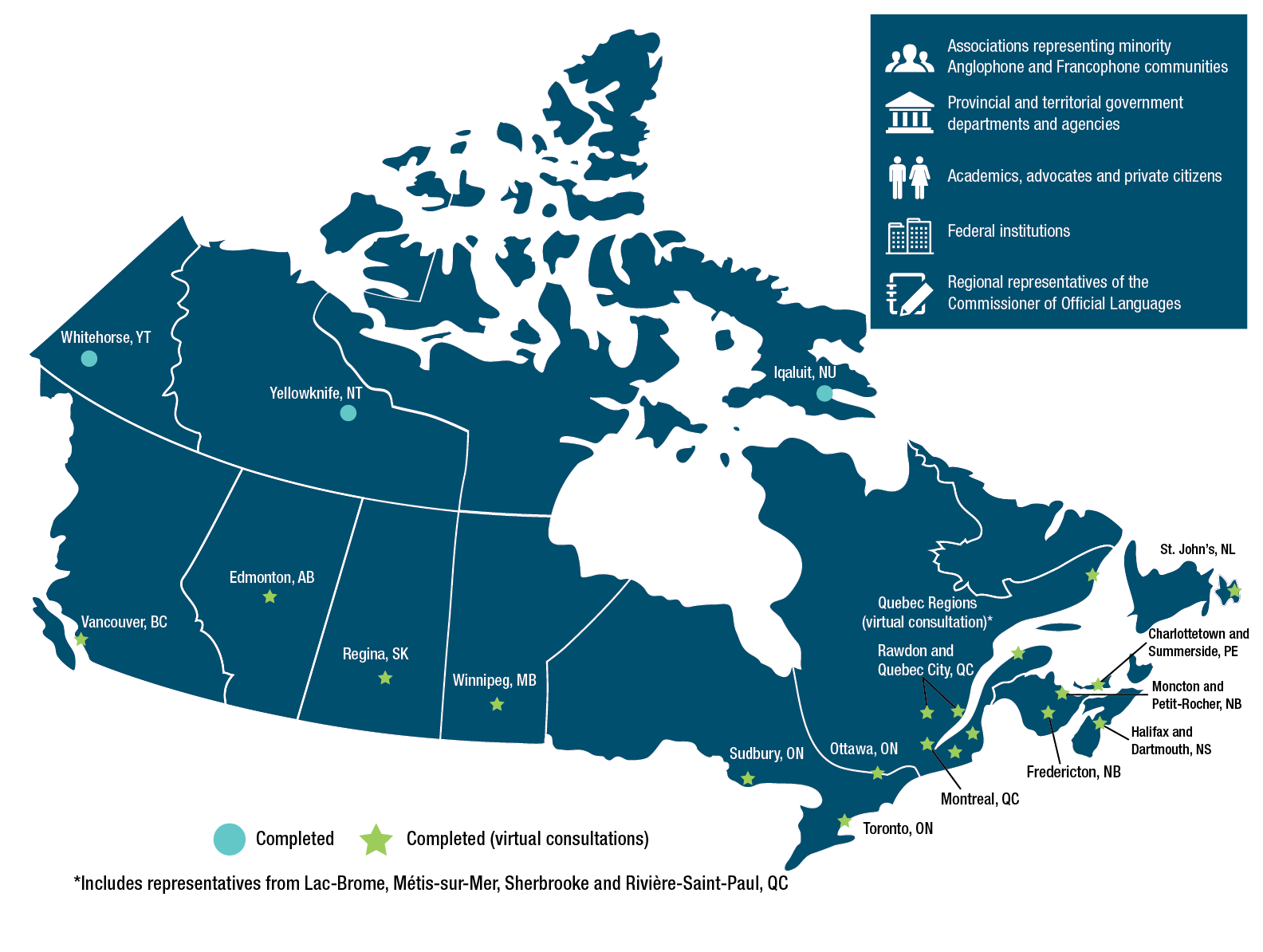
Map 1 - Text version
A map of Canada shows that in-person consultations were completed in Whitehorse, Yellowknife, Iqaluit, and virtual consultations were completed in Vancouver, Edmonton, Regina, Winnipeg, Sudbury, Toronto, Ottawa, Montreal, Rawdon, Quebec City, Fredericton, Halifax, Dartmouth, Moncton, Petit-Rocher, Charlottetown, Summerside and St. John. Digital consultations taking place in Quebec Regions included representatives from Lac-Brome, Métis-sur-Mer, Sherbrooke and Rivière-Saint-Paul.
As part of the review process, OCHRO met with more than 150 stakeholders representing more than 100 organizations and interested parties in all 10 provinces and all 3 territories. The main stakeholders consulted were the following:
- official language minority community organizations (principally those that are members of the Fédération des communautés francophones et acadienne du Canada, for Francophones outside Quebec; and organizations that are members of the Quebec Community Groups Network, for Anglophones in Quebec)
- organizations that support official languages and the promotion of linguistic duality, such as Canadian Parents for French
- representatives from the Office of the Commissioner of Official Languages, including regional offices
- representatives from provincial and territorial governments whose specific mandate is related to official languages
- federal institutions, including Crown corporations and certain privatized organizations subject to the act (for example, Air Canada)
- experts, including academics and legal scholars
The general public was consulted by means of an online survey between April 30 and July 8, 2018. More than 1,500 Canadians responded to the survey and provided input.

1,500 online respondents

60 organizations and lobby groups

150 stakeholders and interested parties
In addition, the President of the Treasury Board set up an Experts Advisory Group in June 2017. Made up of former Senator Claudette Tardif; Senator Raymonde Gagné; former Commissioner of Official Languages Graham Fraser; and Co-Chair of Dialogue New Brunswick, Mirelle Cyr, the group had the mandate of directly advising the President on the review. In total, four technical information sessions were held. All members of the House of Commons and Senate were invited to attend the group’s meetings. Representatives from OCHRO, the Department of Canadian Heritage and Statistics Canada gave presentations and answered questions from the advisory group and parliamentarians.
While the regulatory review is underway, OCHRO continues to monitor the application of the current regulations using the Regulations Management System and to provide advice to institutions. As of March 31, 2018, federal institutions had 11,298 offices,Footnote 2, 3,845 (34.0%) of which were required to offer services to and communicate with the public in both official languages.
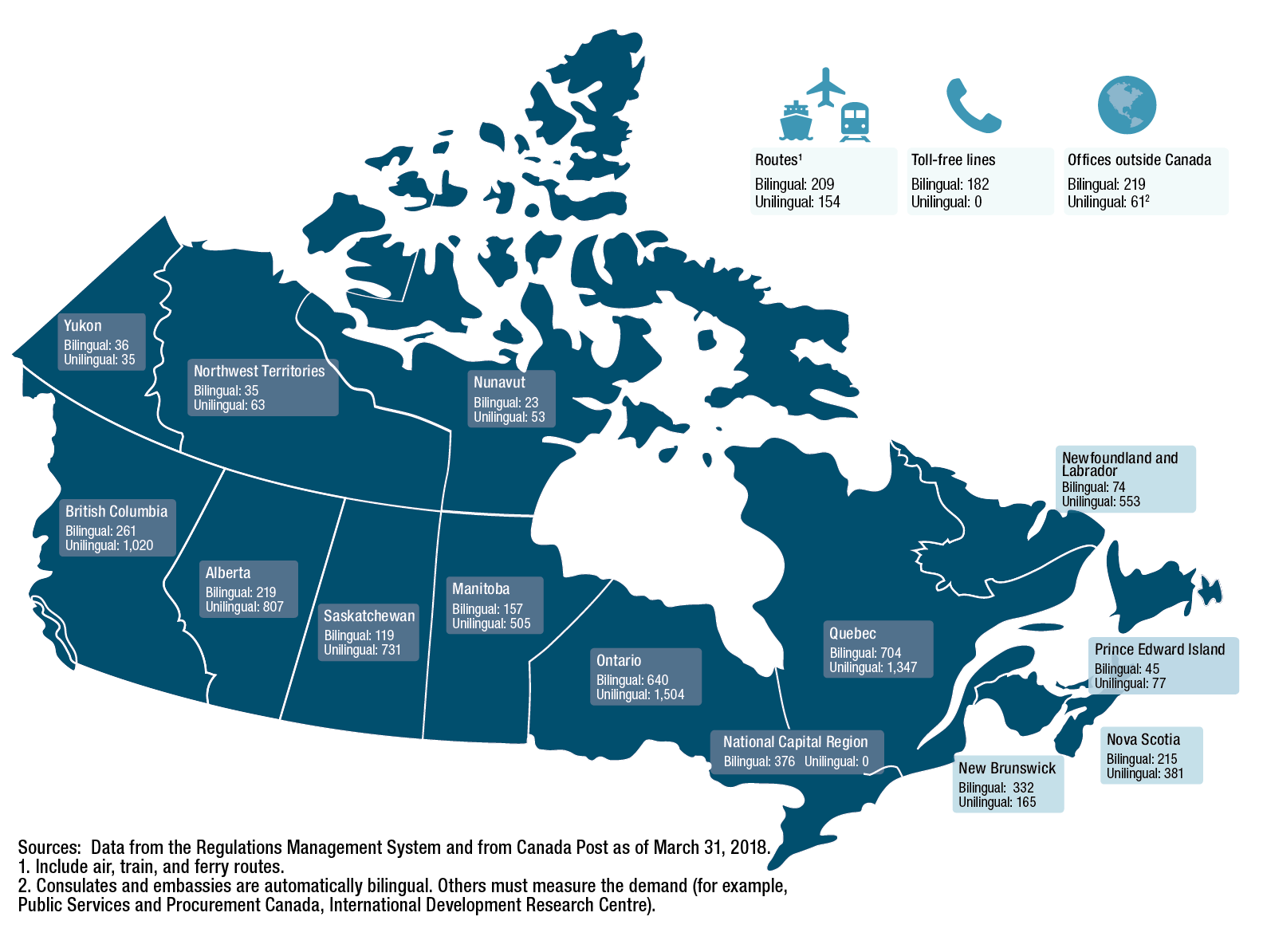
Map 2 - Text version
British Columbia: 261 bilingual offices, 1,020 unilingual; Alberta: 219 bilingual offices, 807 unilingual; Saskatchewan: 119 bilingual offices, 731 unilingual; Manitoba: 157 bilingual offices, 505 unilingual; Ontario: 640 bilingual offices, 1,504 unilingual; National Capital Region: 376 bilingual offices, none unilingual; Quebec: 704 bilingual offices, 1,347 unilingual; New Brunswick: 332 bilingual offices, 165 unilingual; Prince Edward Island: 45 bilingual offices, 77 unilingual; Nova Scotia: 215 bilingual offices, 381 unilingual; Newfoundland and Labrador: 74 bilingual offices, 553 unilingual; Yukon: 36 bilingual offices, 35 unilingual; Northwest Territories: 36 bilingual offices, 63 unilingual; Nunavut: 23 bilingual offices, 53 unilingual; Offices outside Canada: 219 bilingual, 61 unilingual (Consulates and embassies are automatically bilingual. Other offices must measure the demand (for example, Public Services and Procurement Canada, International Development Research Centre)); 182 bilingual toll‑free lines, none are unilingual; Routes: 209 bilingual, 154 unilingual (include air, train and ferry routes). Sources: Data from the Regulatory Management System and from Canada Post as of March 31, 2018.
Although the regulatory review will modernize how bilingual obligations in federal service locations are determined, federal institutions must constantly strive to ensure that services are provided and communications take place in both official languages. OCHRO is responsible for monitoring these efforts and does so in part by using the Treasury Board of Canada Secretariat’s Departmental Results Framework. One indicator in the framework is the percentage of institutions where communications in designated bilingual offices nearly alwaysFootnote 3 occur in the official language chosen by the public. The target for the last few years has been to achieve at least 90% by March 2020. This indicator is based on an average of institutions’ responses to two questions in their review on official languages from the previous fiscal year. The results reported in the Treasury Board of Canada Secretariat 2018–19 Departmental Plan indicate some progress (see Graph 1).

84.5% for fiscal year 2015-2016

84.0% for fiscal year 2016-2017

90.2% for fiscal year 2017-2018
According to the reviews for fiscal year 2016 to 2017, the institutions that were assessed agreed that, in offices that are bilingual for the purposes of communication with and services to the public, oral and written communications nearly always occur in the official language chosen by the public (86% and 96%, respectively). If the results for written and oral communications are averaged, the result for fiscal year 2016 to 2017 reported in the Secretariat’s Departmental Plan for fiscal year 2018 to 2019 is 90.2%, which exceeds the target.
Combined results for fiscal year 2017 to 2018 are higher, as shown in Graph 2: 90% of institutions said that oral communications nearly always occur in the official language chosen by the public, and 95% said the same for written communications.
Graph 2a. Oral communications
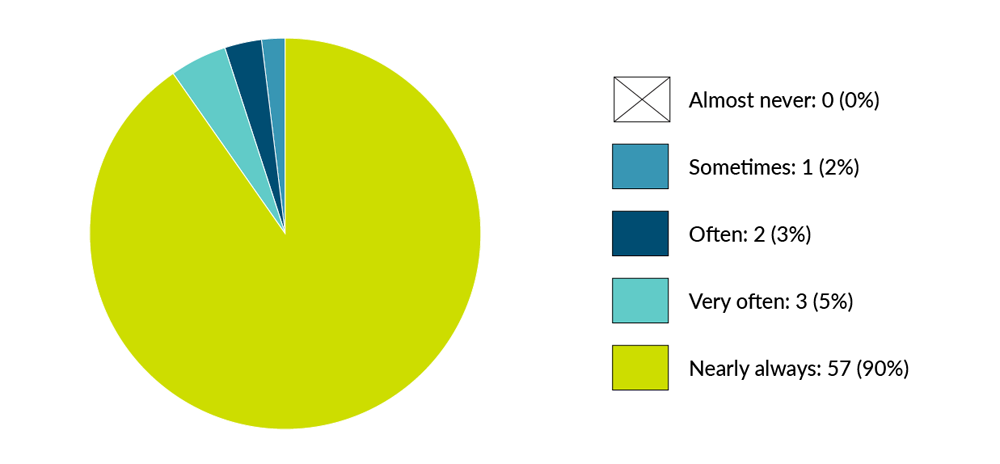
Graph 2a - Text version
| Almost never | Sometimes | Often | Very often | Nearly always | |
|---|---|---|---|---|---|
| Number | 0 | 1 | 2 | 3 | 57 |
| Percentage (%) | 0% | 2% | 3% | 5% | 90% |
Graph 2b. Written communicationsFootnote 5
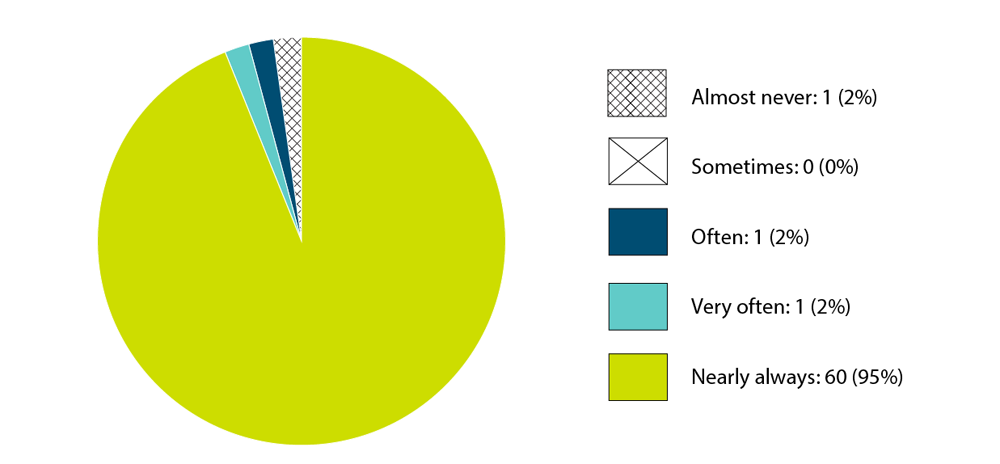
Graph 2b - Text version
| Almost never | Sometimes | Often | Very often | Nearly always | |
|---|---|---|---|---|---|
| Number | 1 | 0 | 1 | 1 | 60 |
| Percentage (%) | 2% | 0% | 2% | 2% | 95% |
To improve the accuracy of institutions’ responses to the questions in their official languages reviews, OCHRO required that they provide some details on the frequency of both oral and written communications. One third of them provided the required details, some of them referring to guidelines or client service standards and investigations, positive report cards from the Office of the Commissioner of Official Languages, the absence of complaints, a high rate of compliance by bilingual staff, many of whom have a high linguistic profile (a profile of CCC), or adequate training for unilingual staff responsible for referring clients to colleagues who can assist members of the public in the official language of their choice.

Canadians believe it is important to have access to federal services in the language of their choice. In fact, according to a study on the appreciation and perception of Canada’s official languages conducted by Vox Pop Labs Inc.Footnote 6 on behalf of Canadian Heritage, 84% of Canadians felt that way. Most respondents (53%, including 50% of those in minority communities), indicated that it was extremely important, the highest level on the scale. Among those aged 18 to 29, 94% agreed it was important; among those over 29, 81% said it was.
According to the same study, 97% of Francophones and 80% of Anglophones believe that it is important to obtain federal government services in the official language of their choice. As well, 96% of Francophones and 79% of Anglophones believe that Francophones living outside Quebec and Anglophones living in Quebec should have access to federal government services in their language. Asked how important it would be for them to have access to federal government services in French if they were living outside their province, 95% of Francophone respondents in Quebec said that it would be important, including 68% who said it would be extremely important.
Anglophone respondents living outside Quebec were also asked to indicate how important it would be for them to have access to federal government services in English if they were living in Quebec: 91% said that it would be important, including 61% who said it would be extremely important.
For the multi-client survey, Citizens First 8, conducted by Ipsos Public Affairs on behalf of the Institute for Citizen‑Centred Service, which aimed to gather detailed data on the main trends in client satisfaction with the delivery of government services to Canadians, the federal government asked that questions be added specific to its services, including one on official languages. Eighty‑five percent (85%) of survey respondents ranked access to service in the official language of their choice highest among various service attributes, ahead of privacy, quality of communication, satisfaction with the channel, outcome and fairness, in order. Among members of official language minority communities who took part in the survey, 73% agreed or strongly agreed that they had access to services in their choice of English or French.Footnote 7
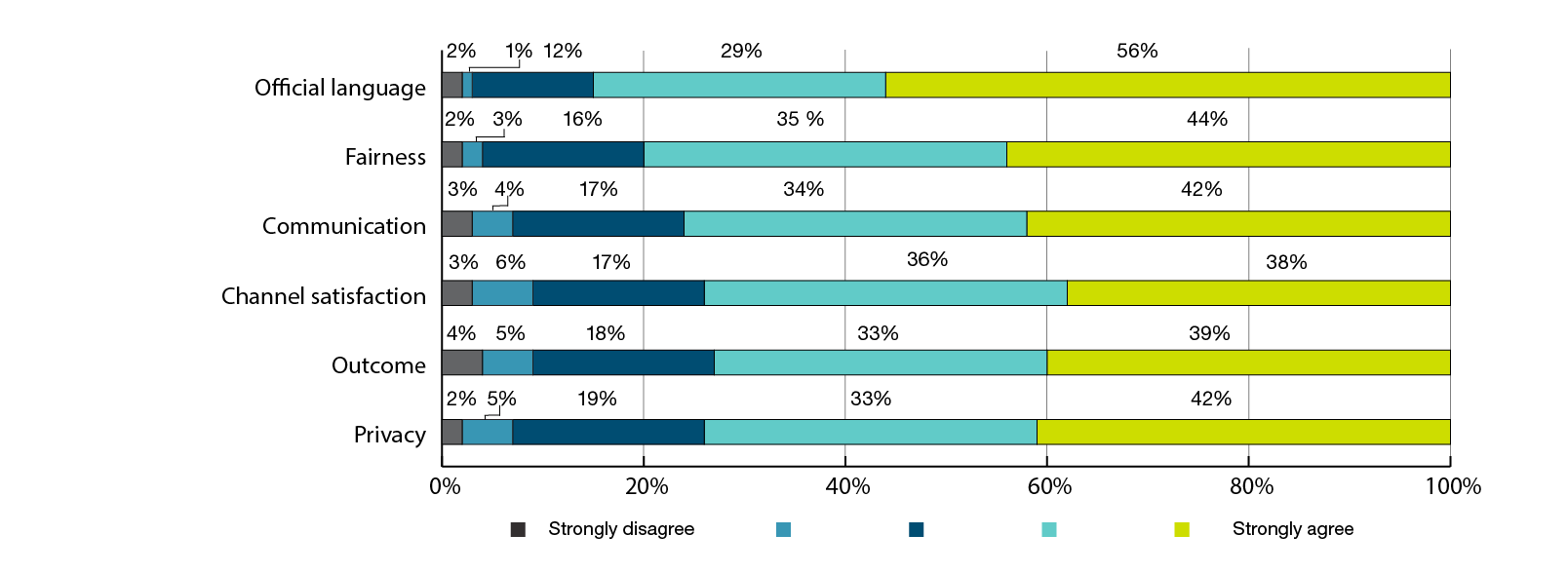
Graph 3 - Text version
| Strongly disagree | Disagree | Neither agree or disagree | Agree | Strongly agree | |
|---|---|---|---|---|---|
| Official language | 2% | 1% | 12% | 29% | 56% |
| Fairness | 2% | 3% | 16% | 35% | 44% |
| Communication | 3% | 4% | 17% | 34% | 42% |
| Channel satisfaction | 3% | 6% | 17% | 36% | 38% |
| Outcome | 4% | 5% | 18% | 33% | 39% |
| Privacy | 2% | 5% | 19% | 33% | 42% |
Federal institutions put in place various measures to ensure active offer when providing services to the public in both official languages in bilingual offices. The Policy on Official Languages defines active offer as follows: “Clearly indicate visually and verbally that members of the public can communicate with and obtain services from a designated office in either English or French.”
In accordance with the Parks Canada Service Standards on active offer, the official languages symbol is prominently displayed at each Parks Canada location. For example, all signs identifying Parks Canada offices or facilities, visitor centres and indoor and outdoor exhibits, welcome kiosks, base camps are all in both official languages, as is any tape identifying closed areas. Text on staff uniforms, including those of park wardens, is also in both official languages.
For many members of the public, the main way to access federal services is the Canada.ca website, where pages are systematically accessible in both official languages. Sixty‑eight percent (68%) of small institutionsFootnote 8 indicated that the English and French versions of their websites are nearly always simultaneously posted in full and are of equal quality; 7% indicated that this is very often the case; and 7%, that it is often the case.
In‑person active offer presents recurring challenges for institutions, which mention it in their reviews. These challenges may explain why the results institutions provide in their reviews are not quite as high for this element. Seventy-eight percent (78%) of all institutions and 74% of small institutions indicate that they nearly always take appropriate measures to greet the public in person in both official languages. However, institutions are also taking measures to improve their results in this regard, particularly by considering the results of their own mystery‑client surveys.
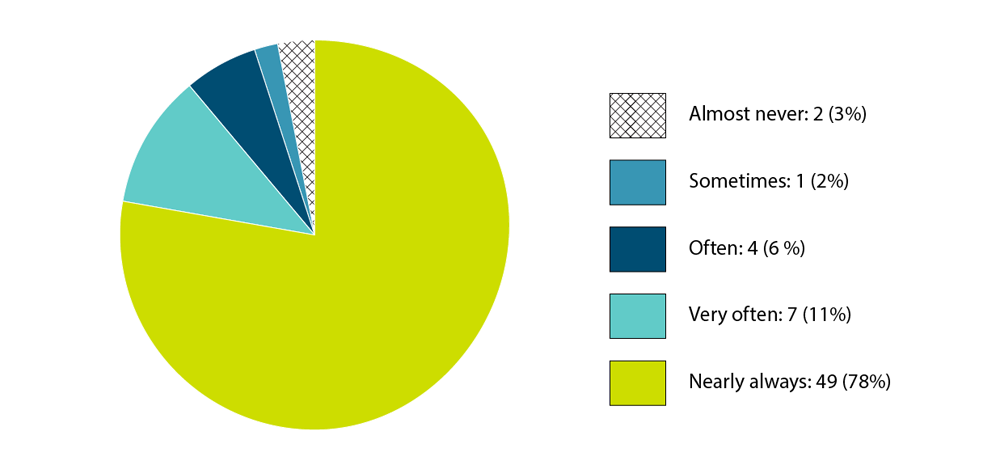
Graph 4 - Text version
| Almost never | Sometimes | Often | Very often | Nearly always | |
|---|---|---|---|---|---|
| Number | 2 | 1 | 4 | 7 | 49 |
| Percentage (%) | 3% | 2% | 6% | 11% | 78% |
Progress has been made since the Treasury Board President’s first annual report on official languages, which covered 1988 to 1989. At that time, of the 39,373 incumbents of bilingual positions that provided service to the public in the core public administration, 85% met the language requirements of their position. In fiscal year 2017 to 2018, 43,417 provided services in both English and French, with 95% meeting the language requirements of their position.
Several institutions indicated that they were putting initiatives in place to ensure that agreements and contracts with third parties contain language clauses. According to 83% of large and key institutions, contracts and agreements with third parties acting on behalf of bilingual offices nearly always contain clauses setting out the language obligations that they must respect. At the Official Languages Good Practices Forum in Ottawa on November 29, 2017, Canadian Heritage shared the language clauses that were included in the funding agreements for the celebrations marking the 150th anniversary of Confederation.Footnote 9
All contracts awarded by Public Services and Procurement Canada contain a clause regarding compliance with applicable laws, including the Official Languages Act. Consequently, suppliers must provide proof of compliance.
In November 2017, Parks Canada audited a sample of 24 instruments between it and third parties. All of the instruments included official languages clauses. That year, the agency adopted three new tools to clarify official languages requirements in instruments signed with third parties:
- an information session for teams responsible for contracts and finances
- a checklist of official languages obligations for employees to use when awarding contracts
- a toolkit for commercial operators
The official languages team produced analyses of the impact of official languages on agreements with third parties and proposed language clauses.
To help employees provide active offer of bilingual services, Agriculture and Agri-Food Canada sent regional employees across the department copies of a tool developed by the Office of the Commissioner of Official Languages entitled “Active offer: A culture of respect, a culture of excellence.” As well, the Public Affairs Branch ensures that spokespersons at open house events and department representatives at kiosks at regional fairs are bilingual.
| Questions | Nearly always (90% to 100% of cases) |
|---|---|
| Oral communications occur in the official language chosen by the public when the office is designated bilingual. | 90% |
| Written communications occur in the official language chosen by the public when the office is designated bilingual. | 95% |
| All communications material is produced in both official languages and is simultaneously issued in full in both official languages when the material comes from a designated bilingual office. | 85% |
| Signs identifying the institution’s offices or facilities are in both official languages at all locations. | 79% |
| The English and French versions of websites are simultaneously posted in full and are of equal quality. (question for small institutions only) | 79% |
| Appropriate measures are taken to greet the public in person in both official languages. | 78% |
| Contracts and agreements with third parties contain clauses setting out the office’s or facility’s language obligations with which the third parties must comply. (question for large and key institutions only) | 83% |
| The language obligations in those clauses have been met. (question for large and key institutions only) | 86% |
| Your institution selects and uses advertising media that reach the targeted public in the most efficient way possible in the official language of their choice. (question for large and key institutions only) | 97% |
Language of work
-
In this section
In 1988, Part V was added to the Official Languages Act to set out the language rights of federal employees. Over the last 30 years, significant progress has been made toward achieving the goal of the 1988 act, which was to create a federal public service in which English and French are recognized and in which Anglophones and Francophones have the same opportunities to use the official language of their choice. Challenges remain, however, particularly with respect to the use of French as a language of work outside Quebec and that of English in Quebec.
Public Service Employee Survey
Two datasets paint a fairly comprehensive picture of English and French as languages of work in the federal public service: the data from the 2017 Public Service Employee Survey and the data from the official languages reviews collected by OCHRO using questions asked of institutions.
The 2017 Public Service Employee Survey was an opportunity for employees to share their perceptions about certain issues in the public service, particularly about six aspects of language of work (see Table 2). The results of the 2017 survey for the questions about the use of official languages in the workplace are similar to the results from the 2008, 2011 and 2014 surveys.
The data from the Public Service Employee Survey shows that, overall, Francophone employees in the public service feel less positive than their Anglophone colleagues about whether they can use the official language of their choice at work.
In particular, Table 2 shows that Francophones clearly feel less comfortable than Anglophones using the official language of their choice in preparing written materials, including email, and when attending meetings (a similar result to that of past surveys).
| Questions | Francophone employees | Anglophone employees | Variance |
|---|---|---|---|
| Question 2. The material and tools provided for my work, including software and other automated tools, are available in the official language of my choice. | 86% | 94% | 8% |
| Question 3. When I prepare written materials, including email, I feel free to use the official language of my choice. | 69% | 94% | 25% |
| Question 23. During meetings in my work unit, I feel free to use the official language of my choice. | 76% | 93% | 17% |
| Question 33. When I communicate with my immediate supervisor, I feel free to use the official language of my choice. | 88% | 95% | 7% |
| Question 50. During meetings in my department or agency, the chairpersons create an environment where I feel free to use the official language of my choice. | 90% | 73% | 17% |
| Question 51. The training offered by my department or agency is available in the official language of my choice. | 85% | 92% | 7% |

The data from the survey also reveals that Francophone employees in the National Capital Region and in Ontario are more likely to have to overcome challenges relating to language of work than are Francophone employees in Quebec. Also, Anglophone employees in Quebec have more difficulty using English at work than Anglophone employees elsewhere in the country.
The most notable differences between employees in bilingual positions whose first official language is French and those whose first official language is English is in how free they feel to use the official language of their choice when preparing written materials.
That said, a comparison of the results of the 2017 and 2014 surveys shows that the situation in regions designated bilingual for language‑of‑work purposes improved for Anglophone employees in Quebec and for Francophone employees outside Quebec (Graph 5). However, the situation of Francophone employees in regions not designated as bilingual outside Quebec deteriorated slightly, except in Prince Edward Island, where it improved.
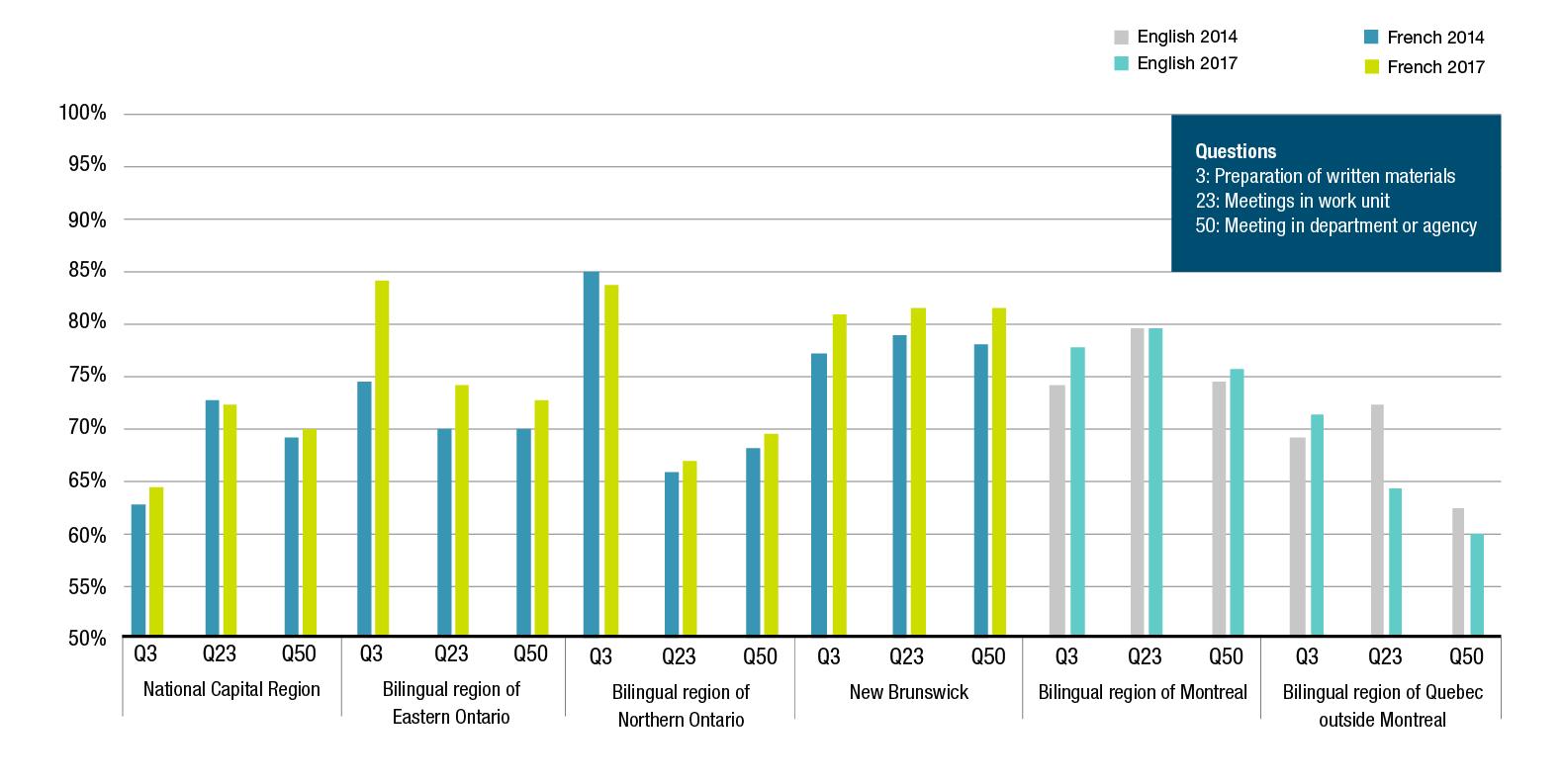
Graph 5 - Text version
| National Capital Region | Bilingual region of Eastern Ontario | Bilingual region of Northern Ontario | New Brunswick | Bilingual region of Montreal | Bilingual regions of Quebec outside Montreal | |||||||||||||
|---|---|---|---|---|---|---|---|---|---|---|---|---|---|---|---|---|---|---|
| Q3 | Q23 | Q50 | Q3 | Q23 | Q50 | Q3 | Q23 | Q50 | Q3 | Q23 | Q50 | Q3 | Q23 | Q50 | Q3 | Q23 | Q50 | |
| English 2014 | N/A | N/A | N/A | N/A | N/A | N/A | N/A | N/A | N/A | N/A | N/A | N/A | 74% | 79% | 74% | 69% | 73% | 63% |
| French 2014 | 63% | 73% | 69% | 74% | 70% | 70% | 85% | 66% | 67% | 77% | 79% | 78% | N/A | N/A | N/A | N/A | N/A | N/A |
| English 2017 | N/A | N/A | N/A | N/A | N/A | N/A | N/A | N/A | N/A | N/A | N/A | N/A | 77% | 79% | 76% | 72% | 64% | 60% |
| French 2017 | 64% | 72% | 70% | 84% | 74% | 73% | 84% | 67% | 69% | 81% | 82% | 82% | N/A | N/A | N/A | N/A | N/A | N/A |
The data OCHRO gathered through the official language reviews back up these results to a large degree. In fact, they show that almost all federal institutions surveyed by OCHRO find that they nearly always or very often comply with the act when providing material and tools in the official language of the employee’s choice, or when supervising or training their staff in English and French.
However, graphs 6 and 7 show that only 85% of federal institutions reported that their staff nearly always or very often were able to prepare documents in the official language of their choice and that a lower percentage of all institutions that submitted a review for fiscal year 2017 to 2018 (70%) stated that meetings are nearly always or very often conducted in both official languages in regions designated as bilingual.
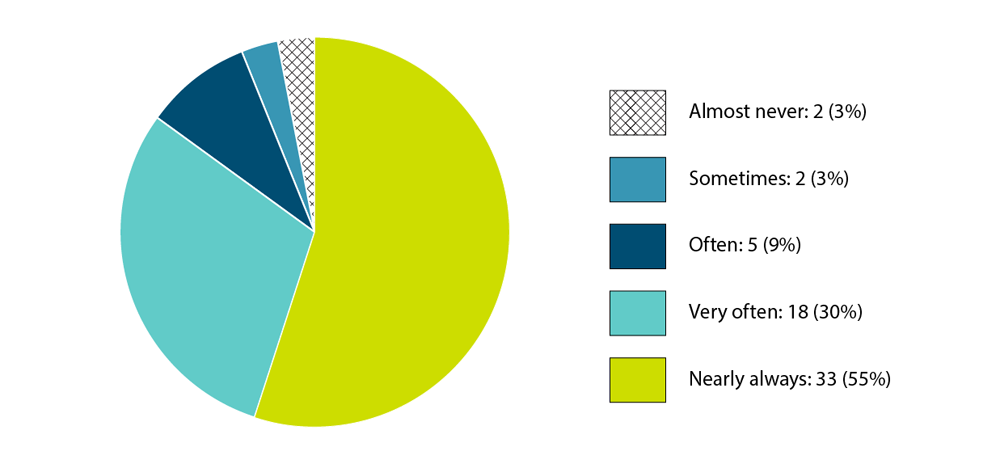
Graph 6 - Text version
| Almost never | Sometimes | Often | Very often | Nearly always | |
|---|---|---|---|---|---|
| Number | 2 | 2 | 5 | 18 | 33 |
| Percentage (%) | 3% | 3% | 9% | 30% | 55% |
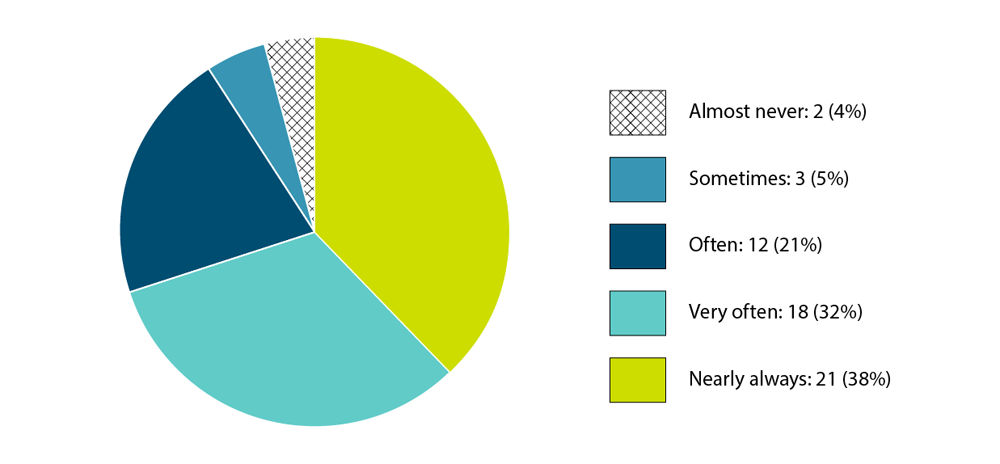
Graph 7 - Text version
| Almost never | Sometimes | Often | Very often | Nearly always | |
|---|---|---|---|---|---|
| Number | 2 | 3 | 12 | 18 | 21 |
| Percentage (%) | 4% | 5% | 21% | 32% | 38% |
Although remarkable progress has been made since the Act was passed, it must be admitted that the expected results in the area of language of work have not been fully achieved. French has not yet attained its rightful place as a language of work in the Public Service of Canada. This situation seems to be attributable to social and cultural factors. Some Francophones use English more often than French when speaking to their Anglophone colleagues, and sometimes even to other Francophones. Many English speakers take language training but do not avail themselves of opportunities to use their new skills, or else do not feel confident enough to speak French, so they have difficulty maintaining their language skills.
Bilingual supervision
Under the Directive on Official Languages for People Management, managers and supervisors “are responsible for supervising employees located in bilingual regions in the official language of the employee’s choice when they occupy bilingual or either/or positions, and in the language of the position when they occupy unilingual positions.”
Seventy-six percent (76%) of all institutions and 86% of small institutions stated that incumbents of bilingual or either/orFootnote 11 positions are nearly always supervised in the official language of their choice, regardless of whether the supervisors are located in bilingual or unilingual regions. Thirteen institutions do not have offices in bilingual regions; and eight, including seven small institutions, indicated that the question did not apply to them.
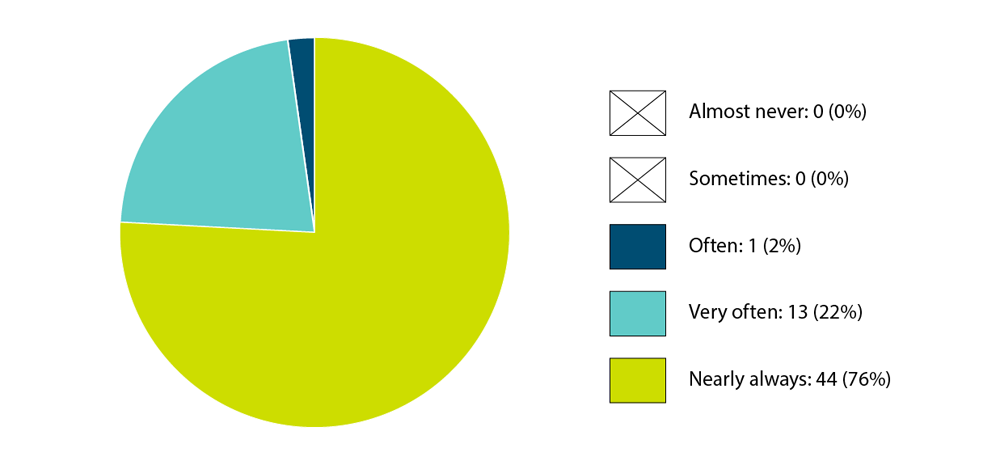
Graph 8 - Text version
| Almost never | Sometimes | Often | Very often | Nearly always | |
|---|---|---|---|---|---|
| Number | 0 | 0 | 1 | 13 | 44 |
| Percentage (%) | 0% | 0% | 2% | 22% | 76% |
In March 2016, the Canada Border Services Agency launched a new strategy to offer its supervisors advanced language training to improve its official languages performance. The agency implemented administrative measures in cases where a supervisor did not have the language proficiency needed to supervise an employee in the language of his or her choice because of a change in the linguistic profile of the position or a short-term acting assignment.
As of March 31, 2018, 94.7% of incumbents in the 24,164 bilingual supervisory positions in the core public administrationFootnote 12 met the language requirements of their position, and 57.6% of those positions required level C proficiency in oral interaction. (See tables 11 and 12 in Appendix D.)
Personal and central services
The Directive on Official Languages for People Management indicates that institutions are responsible for “providing personal and central services to employees in bilingual regions in the official language of the employee’s choice.”
According to 79% of institutions that submitted a review, personal and central services are nearly always provided to employees in bilingual regions in the language of their choice. For small institutions, 84% indicated that this is nearly always the case. Nine institutions, all small, indicated that the question did not apply to them.
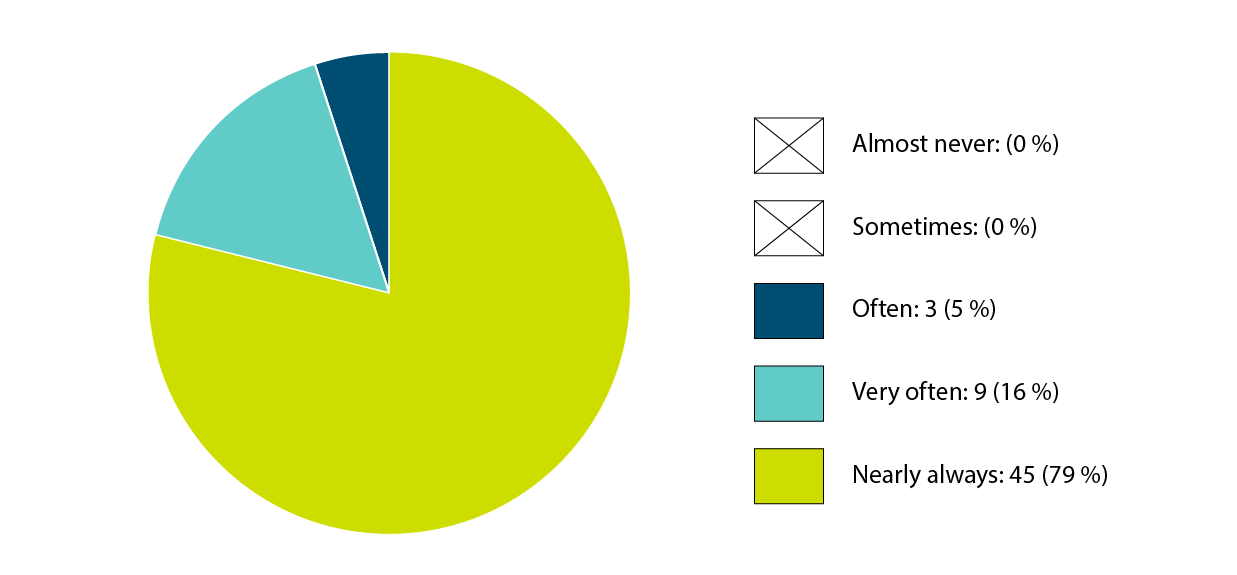
Graph 9 - Text version
| Almost never | Sometimes | Often | Very often | Nearly always | |
|---|---|---|---|---|---|
| Number | 0 | 0 | 3 | 9 | 45 |
| Percentage (%) | 0% | 0% | 5% | 16% | 79% |
Employees at Defence Construction Canada are asked to indicate their preferred language of work in writing when they join the Crown corporation. It gathers this information to ensure that it communicates with employees in the language of their choice in weekly newsletters, job postings and general communications, and in training and awards. It is also the language in which employees receive their performance evaluations. Employees can change their chosen language of work at any time by contacting Human Resources Services.
As of March 31, 2018, 94.7% of incumbents of the 58,134 bilingual positions that provide personal and central services in the core public administration met the language requirements of their position, and 36.1% of those positions required level C proficiency in oral interaction. (See tables 9 and 10 in Appendix D.)
The results of the 2017 Public Service Employee Survey indicate that 83% of employees at Statistics Canada are comfortable preparing written materials in the language of their choice, although they can do so at any time in bilingual offices. Statistics Canada offers fast and efficient editing and translation services to meet language requirements, while allowing employees to prepare their documents in the official language of their choice.
Training and professional development
According to the Directive on Official Languages for People Management, managers and supervisors must ensure that training and professional development is available to employees in bilingual regions in the official language of their choice. Large and key institutions reported that their employees nearly always (74%) or very often (21%) obtain training or professional development in the official language of their choice.Footnote 13
Mandatory training at Public Services and Procurement Canada is offered in both official languages. As well, the department’s branches ensure that training is available to employees in the official language of their choice, particularly training developed by their own sector, as is the case for the Human Resources Branch and the Policy, Planning and Security Branch.
Documentation and work instruments
According to the Directive on Official Languages for People Management, “managers and supervisors are responsible for…providing employees in bilingual regions with regularly and widely-used work instruments and electronic systems…in both official languages.” Most large and key institutions responded that this is nearly always the case (79%) or very often the case (21%).

Report on Language of Work
The report to the Clerk of the Privy Council entitled The Next Level: Normalizing a Culture of Inclusive Linguistic Duality in the Federal Public Service Workplace, was released in September 2017. The report, prepared by Patrick Borbey and Matthew Mendelsohn, examined the state of bilingualism in the federal public service and made recommendations to ensure that it is evolving to meet the needs of public servants, and Canadians, in both official languages.
The Clerk mandated the Committee of Assistant Deputy Ministers on Official Languages (CADMOL) to oversee the implementation of the report’s recommendations and to provide him with an update twice a year. To support CADMOL in its oversight role, OCHRO, in collaboration with Canadian Heritage, has guided and aligned the efforts of the various departments and working groups involved in implementing the recommendations.
As a first step, the 26 recommendations were reviewed, analyzed and organized into 14 recommendations, 8 of which OCHRO is either directly responsible for or a key partner in. The 8 recommendations aim, in particular, to:
- increase the use of both official languages in the workplace by strengthening accountability and by recognizing leaders who promote and contribute to a bilingual work environment
- increase awareness of the rights and linguistic obligations of public servants
- improve the effectiveness and efficiency of the language training provided to employees
- offer employees new opportunities to learn their second official language and to maintain the language skills they have acquired
- adapt policy instruments so that they better reflect the linguistic realities of all public servants, including those who belong to employment equity groups
By addressing the above recommendations, OCHRO is ultimately seeking to build a rigorous, modern and inclusive official languages framework that is adapted to the second-language proficiency level required for serving Canadians and supervising employees; that is supported by an innovative and flexible language-learning continuum; and that and meets the needs of a high‑performing public service.

In fiscal year 2017 to 2018, the recommendations in the report were discussed in various forums organized by OCHRO or by OCHRO in collaboration with other federal institutions. These forums included:
- the Conference of Official Languages Champions (June 1, 2017)
- Linguistic Duality Day (September 14, 2017)
- the Departmental Advisory Committee on Official Languages (October 24, 2017)
- the Official Languages Best Practices Forum (in November 2017)
Although the recommendations in the report did not target Crown corporations, the members of the Crown Corporations Advisory Committee on Official Languages were provided with an overview of the recommendations on October 26, 2017, and had the opportunity to discuss those relating to language of work.
In the spring of 2018, the first progress report, prepared by Canadian Heritage and OCHRO, was submitted to the Clerk. The report was signed by the Deputy Minister of Canadian Heritage and included a dashboardFootnote 14 that shows the status of implementation of the recommendations. Highlights included:
- a decision by CADMOL that the Language Portal of Canada be positioned as a single window to showcase official languages tools and best practices
- a decision tree, developed by the Interdepartmental Official Languages Learning Task Team, to prioritize access to language training in departments
- the creation of a Technical Advisory Committee on Procurement Tools for Language Training
- a pilot project by the Public Service Commission allowing hiring managers to assess oral interaction skills at the B-level
- a second-language internship program between the public service and linguistic minority communities, developed by Canadian Heritage
- an interdepartmental meeting organized by OCHRO to assess the financial, operational and other impacts on departments of increasing the linguistic profile for bilingual supervisory positions to a superior proficiency level

| Questions | Nearly always (90% to 100% of cases) |
|---|---|
| In regions designated as bilingual for language-of-work purposes | |
| Incumbents of bilingual or either/or positions are supervised in the official language of their choice, regardless of whether the supervisors are located in bilingual or unilingual regions. | 76% |
| Personal and central services are provided to employees in bilingual regions in the official language of their choice. | 79% |
| The institution offers training to employees in the official language of their choice. (question for large and key institutions only) | 74% |
| Meetings are conducted in both official languages, and employees may use the official language of their choice. | 38% |
| Documentation and regularly and widely used work instruments and electronic systems are available to employees in the official language of their choice. (question for large and key institutions only) | 79% |
| Employees can prepare documents in the official language of their choice. | 55% |
| In unilingual regions | |
| Regularly and widely used work instruments are available in both official languages for employees who are responsible for providing bilingual services to the public or to employees in bilingual regions. | 89% |
Participation of English-speaking and French-speaking Canadians
A public service that reflects the population is more likely to share its experiences and perspectives in the workplace, to develop policies that target the socioeconomic issues that it identifies, and to serve the public well. Linguistic and cultural differences are a source of enrichment that all Canadians can benefit from and are the envy of many countries.
Under Part VI of the act, the Government of Canada is committed to ensuring that:
- English-speaking Canadians and French-speaking Canadians, without regard to their ethnic origin or first language learned, have equal opportunities to obtain employment and advancement in federal institutions; and
- the composition of the workforce of federal institutions tends to reflect the presence of both the official language communities of Canada, taking into account the characteristics of individual institutions, including their mandates, the public they serve and their location.
Certain federal institutions ensure that they communicate job opportunities that are open to the public to organizations that represent minority communities or minority-language teaching institutions so that they can send them to their members in the hopes of expanding the pool of applicants.
On March 31, 2018, in the core public administration, the participation rate was 69% for Anglophones and 30.9% for Francophones. In all institutions subject to the act, the participation rate was 74% for Anglophones and 25.9% for Francophones (see Table 18 in Appendix D).
According to data from the 2016 Census, 75.4% of the Canadian population have English as their first official language and 22.8%, French. Based on a comparison between the 2018 participation rates cited above and the most recent data from the 2016 Census, employees from both official language communities continue to be well represented in all federal institutions subject to the act. The participation rates of the two linguistic groups have remained relatively stable over the past seven years.
In each province and territory, official language minority communities are well represented in all federal institutions. However, Anglophones in Quebec outside the National Capital Region make up 10.4% of the core public administration, although they make up 13.7% of the province’s population. In Yukon, Francophones hold 3.2% of the positions in the core public administration and represent 4.6% of the territory’s population. See Table 13 in Appendix D for a breakdown of participation of Anglophones and Francophones in the core public administration, by province, territory or region.
Human resources management
It would be impossible to provide services to the public or employees or to supervise employees in their language of choice without careful human resources management in institutions that are subject to the act.
The Treasury Board imposes human resources requirements on institutions, and institutions frequently contact the Official Languages Centre of Excellence for advice and interpretations of official languages requirements.
Institutions adopt various human resources management practices in order to provide services to the public and to employees. The 38 large and key institutions that submitted official languages reviews for fiscal year 2017 to 2018 stated that they nearly always (87%) have the resources they need to meet their language obligations relating to service to the public and language of work.
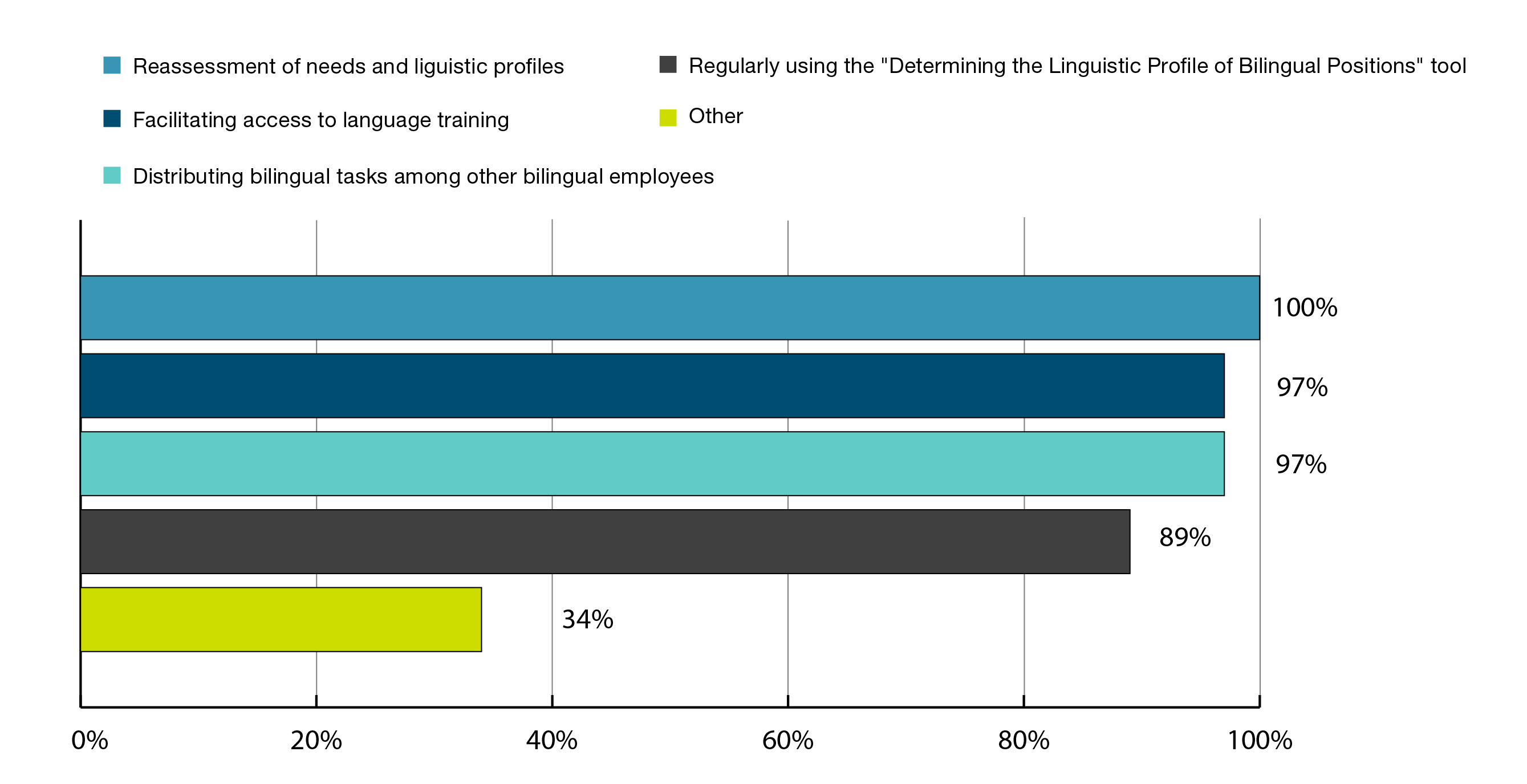
Graph 10 - Text version
| Reassessment of needs and linguistic profiles | 100% |
|---|---|
| Facilitating access to language training | 97% |
| Distributing bilingual tasks among other bilingual employees | 97% |
| Regularly using the “Determining the Linguistic Profile of Bilingual Positions” tool | 89% |
| Other | 34% |
With respect to whether administrative measures are taken to ensure that bilingual duties are carried out and that services are provided to the public and employees in the official language of their choice when required by Treasury Board policy, 92% of all institutions and 92% of small institutionsFootnote 15 indicated that they nearly always are.
The number of bilingual positions in the core public administration increased by 5% from fiscal year 2017 to 2018 to fiscal year 2016 to 2017, to 81,863 positions, or 42.9% of all positions. Overall, 94.9% of incumbents meet the language requirements of their position. The percentage of bilingual positions that require Level C proficiency for oral interaction is the same as for fiscal year 2016 to 2017 (35.3%).
Of all the institutions that submitted a review and that have bilingual positions, 79% nearly always recruit candidates for those positions who are bilingual at the time of their appointment. This is nearly always the case for 80% of small institutions that have bilingual positions, and nine institutions (the same ones as for the previous question) indicated that the question did not apply to them.
Of the 38 large and key institutions that submitted a review, 39% nearly always provide their employees with language training for career advancement.
Canada Post entered into an agreement with an outside organization to provide Canada-wide access to official language training services for full-time and part-time employees. The types of courses provided across Canada range from basic to advanced training in English and French. The training can be taken in person, in a classroom; with an online teacher in a virtual classroom; as a self-guided online course; through a mix of those; or in private, semi-private or group lessons. Employees can visit the learning page on Canada Post’s intranet site to find other training programs to improve their language skills in order to support the institution’s official language obligations.
Parks Canada has implemented an informal language partners program called “Telefun.” The program is offered to all Parks Canada employees, regardless of their work location or their skill level. The program lets them find a co-worker or be matched with someone by the coordinator to then interact in their second language in a friendly and stress-free environment. The program also provides a toolbox that includes approaches and suggestions for conversation topics. A discussion group for language help was also created. Since September 2017, 78 Parks Canada employees have registered for the program that helps them feel more confident when using their second language and learn more about official language minority communities. Ultimately, it is helping serve visitors and clients better in the official language of their choice.
| Questions | Nearly always (90% to 100% of cases) |
|---|---|
| Overall, the institution has the necessary resources to meet its language obligations relating to services to the public and language of work. (question for large and key institutions only) | 87% |
| The language requirements of bilingual positions are established objectively. Linguistic profiles reflect the duties of employees or their work units and take into account the obligations related to services to the public and language of work. | 81% |
| Bilingual positions are staffed by candidates who are bilingual on appointment. | 79% |
| Administrative measures are taken to ensure that the public and employees are offered services in the official language of their choice, as required by Treasury Board policies. | 92% |
| Language training is provided for career advancement. (question for large and key institutions only) | 39% |
| The institution provides working conditions conducive to the use and development of the second-language skills of employees who are returning from language training and, to that end, gives employees all reasonable assistance to do so, particularly by ensuring that they have access to the tools necessary for learning retention (statement for large and key institutions only). | 57% |
Governance

Every federal institution is required to have an official languages unit and to have a person responsible for official languages and an official languages champion. The official languages champion and the person responsible for official languages play key roles in their institution to implement official language obligations and promote them. In 89% of large and key institutions, the champion or co-champions and the persons responsible for Parts IV, V, VI and VII of the act meet regularly to discuss the official languages file.
An official languages committee or network is another mechanism that many institutions use to foster coordinated implementation of their official language program. In fact, of the 38 large and key institutions that submitted a review, 33 have established an official languages committee, network, or working group made up of representatives from different sectors or regions, which meets regularly (81%) or sometimes (19%) to deal horizontally with questions related to language obligations.
The role of the official languages champion is generally to exert influence and provide leadership in his or her institution by improving the visibility of official languages and by promoting official languages, particularly on the senior management committee of their institution. This year, institutions’ reviews show that many of them are discussing official languages on their senior management committee. In fact, for almost all large and key institutions, language obligations are regularly (68%) or sometimes (32%) on the senior management committee’s agenda.
On June 1, 2017, OCHRO supported the Council of the Network of Official Languages Champions by helping organize the annual Conference of Official Languages Champions on the theme of strengthening executive leadership in official languages. The conference activities included an awareness session for senior executives on their obligations and the opportunities that lie ahead.
At Public Services and Procurement Canada, ambassadors representing each branch and region are supported by the Official Languages Coordinators Network, whose members meet every two months to discuss topics involving official languages. In 2017, the department also created a language training coordinators network, the mandate of which is to provide a space to share and discuss issues relating to language training and to support members in their role as coordinators.
Following the publication of the report on language of work in the public service, the Committee of Assistant Deputy Ministers on Official Languages was mandated to follow up on the implementation of the recommendations. The committee met four times during the fiscal year. OCHRO co‑chairs the committee, coordinates the meetings and any resulting action items, and liaises with the working groups that were formed in response to the report’s recommendations. The committee must report to the Clerk twice a year on its progress.
Employment and Social Development Canada has an official languages governance structure that incorporates national and regional perspectives for all parts of the act. The entire official languages governance structure at this department falls under the Official Languages Steering Committee, an intradepartmental committee made up of the directors general and directors from the three branches that are responsible for the act, along with the official languages champions and official languages representatives from the four regions and from all of the department’s branches. The steering committee meets every quarter to discuss issues relating to the implementation of the act. As a subcommittee in the department’s governance structure, the Official Languages Steering Committee provides semi‑annual updates to the Corporate Management Committee, which is composed of the Chief Operating Officer of Service Canada and all of the department’s assistant deputy ministers. This committee demonstrates the department’s commitment to official languages, improves the visibility of official languages among senior management and makes them more aware of related issues. When issues surrounding official languages obligations arise during the year, they are incorporated into the meeting agendas of the senior management committee for discussion. In addition, each of the four regions has a governance structure and a regional intersectoral committee on official languages.
| Questions | Yes or regularly |
|---|---|
| Taking into consideration the size and mandate of the institution, performance agreements include performance objectives related to the implementation of Parts IV, V, VI, and VII (section 41) of the Official Languages Act, as needed. | 60% |
| Obligations arising from Parts IV, V, VI, and VII (section 41) of the Official Languages Act are on the Senior Management Committee’s agenda. (question for large and key institutions only) | 68% |
| The champion or co-champions and the person or persons responsible for Parts IV, V, VI and VII (section 41) of the Official Languages Act meet to discuss the official languages file. (question for large and key institutions only) | 89% |
| An official languages committee, network or working group made up of representatives from the different sectors or regions meets to deal horizontally with questions related to Parts IV, V, VI, and VII (section 41) of the Official Languages Act. (question for large and key institutions only) | 81% |
Monitoring
Providing services to Canadians and to federal employees in the language of their choice and maintaining a work environment that is conducive to the use of both official languages would remain mere principles if institutions did not monitor how official languages programs are implemented. Monitoring allows institutions to take stock of their progress and to report on it to OCHRO and to parliamentarians through the official language reviews and the supporting evidence.
Of all the institutions that submitted a review, 59 (92%) stated that they regularly take measures to ensure that employees are aware of the obligations related to various parts of the act. This is the case for 81% of small institutions.
Veterans Affairs Canada uses various means to inform its employees of the federal government’s obligations under the Official Languages Act. Articles are published regularly in the Carillon Express, the electronic billboard on the department’s intranet site, which also includes a separate section on official languages that features the relevant acts, policies and directives. In 2017, the department created two new guides titled “Language of Work at Veterans Affairs: It’s a Matter of Respect!” and “Delivering Services in Both Official Languages—Active Offer of Service,” which are intended for department employees and managers. The official languages champion promotes official languages by sending emails to all staff and by using the department’s intranet site to highlight national bilingualism recognition activities, such as the Rendez-vous de la Francophonie, in March, and Linguistic Duality Day, in September.
Institutions have several mechanisms at their disposal to verify the quality and availability of services in both official languages. During the fiscal year, 92% of all institutions and 100% of large and key institutions conducted activities to measure the availability and quality of services offered to the public in both official languages. Graph 11 shows the methods used by institutions for those activities.
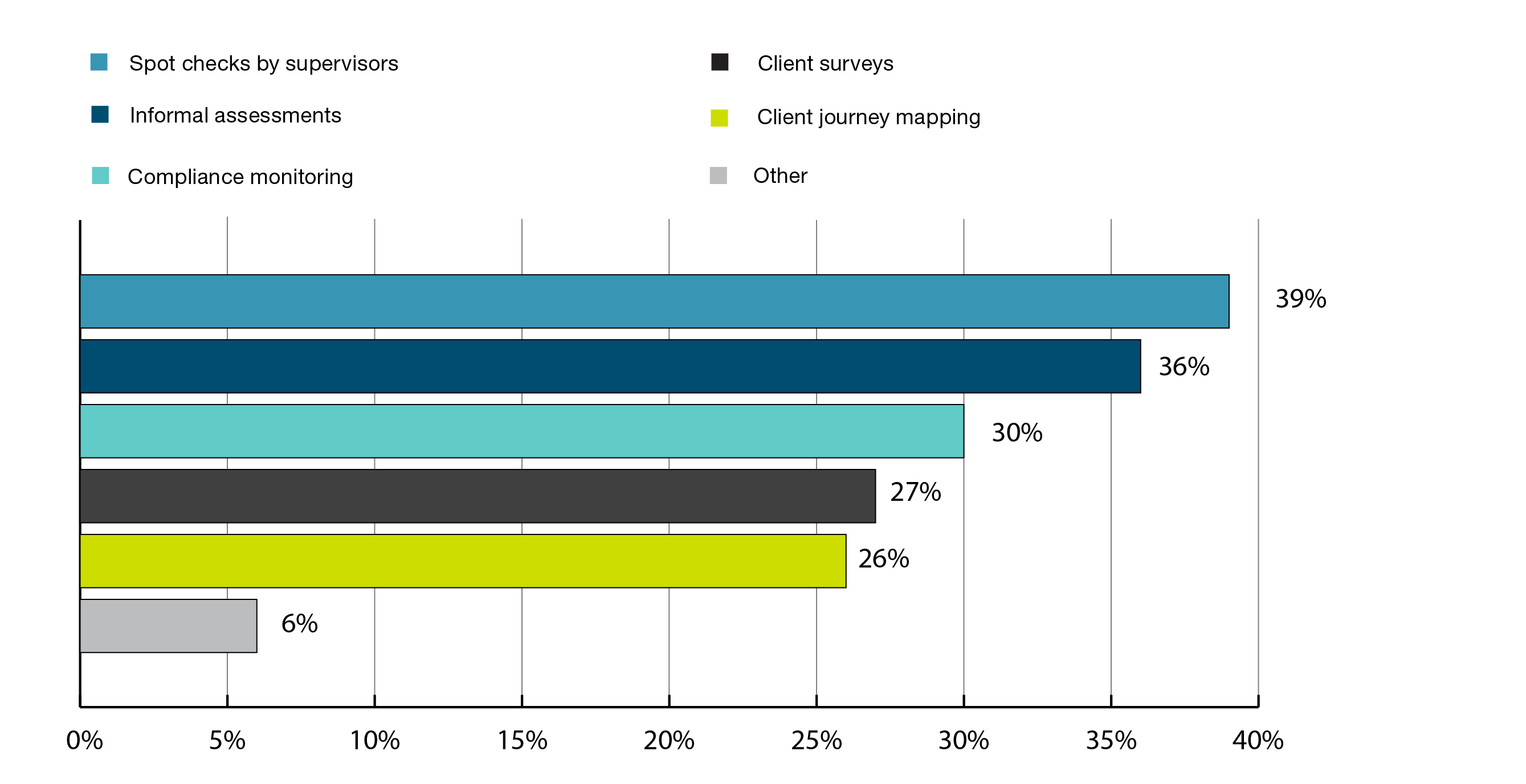
Graph 11 - Text version
| Spot checks by supervisors | 39% |
|---|---|
| Informal assessments | 36% |
| Compliance monitoring | 30% |
| Client surveys | 27% |
| Client journey mapping | 26% |
| Other | 6% |
With respect to language of work, many institutions used the results of the 2017 Public Service Employee Survey to measure the use of official languages in the workplace, since it is a reliable way of finding out employees’ opinions on language of work. However, institutions are not limited to using just the Public Service Employee Survey. In fact, 76% of all institutions, including 65% of small institutions and 79% of large and key institutions, carried out activities to periodically measure whether employees in regions designated bilingual for the purposes of language of work can use the official language of their choice in the workplace. Several institutions conduct their own internal surveys or even use other mechanisms, as is demonstrated by the following results.
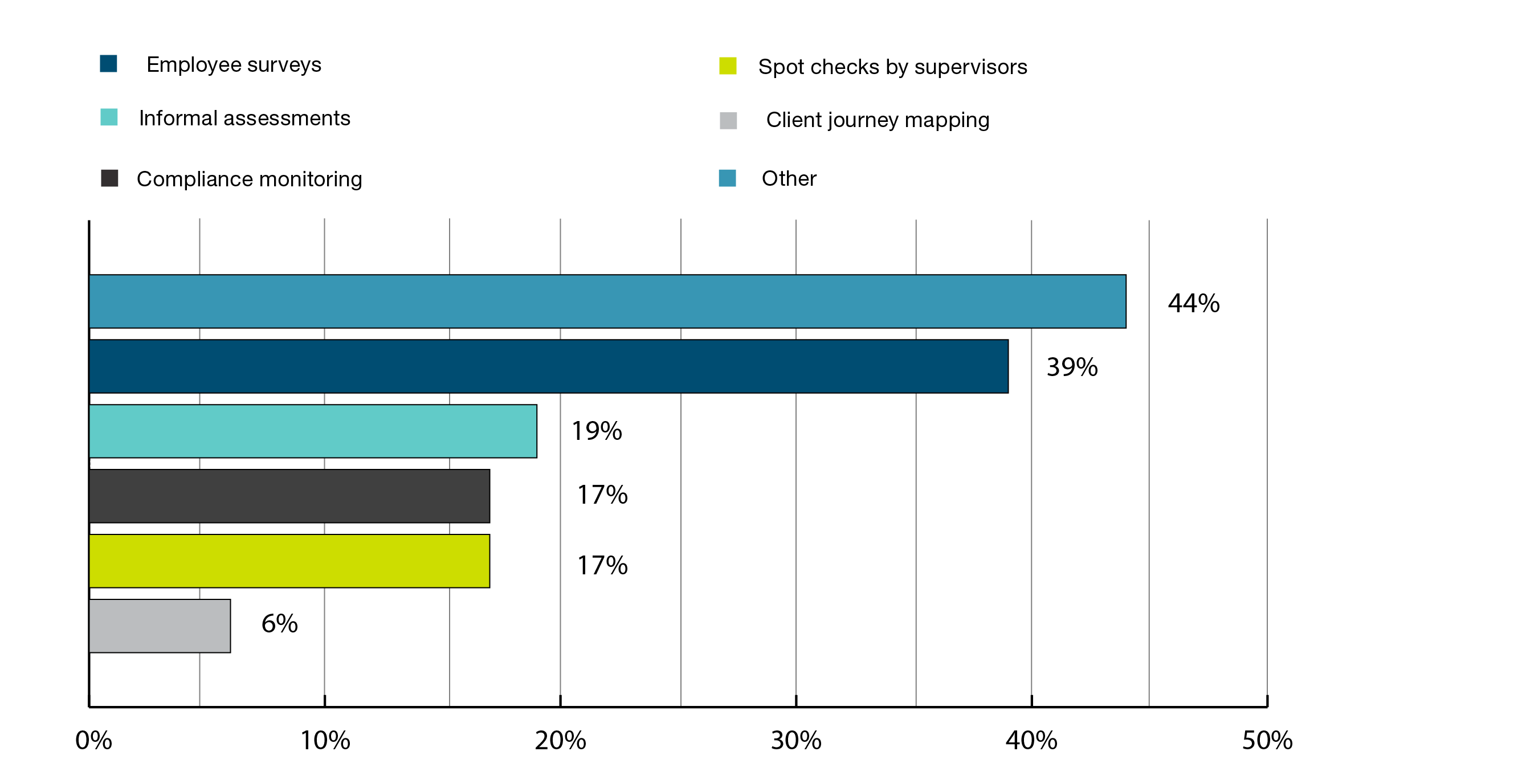
Graph 12 - Text version
| Employee surveys | 39% |
|---|---|
| Informal assessments | 19% |
| Compliance monitoring | 17% |
| Spot checks by supervisors | 17% |
| Client journey mapping | 6% |
| Other | 44% |
Seventy‑four (74%) of all institutions, including 44% of small institutions and 94% of large and key institutions, have mechanisms in place to determine whether their decisions have an impact on the implementation of the act. Such decisions might have to do with adopting or revising a policy, creating or eliminating a program, or establishing or closing an office. Several institutions cite the use of the Official Languages Requirements and Checklist, a systematic analysis of impacts on official languages, which accompanies Treasury Board submissions for these types of initiatives, in consultation with their internal official languages team and, when the summary analysis reveals an impact, they perform a more in-depth analysis that they attach to the submission. These analyses are reviewed by analysts at the Treasury Board of Canada Secretariat. Some institutions use the same analysis chart for memoranda to Cabinet. Every year, several institutions review the list of their offices that are subject to the regulations in order to update the Burolis database, the official, publicly accessible directory of all federal offices and service locations, indicating the language(s) used at each one. Others indicate that decisions of this kind are discussed during senior management committee meetings.
Two other monitoring mechanisms that institutions may use are audits and evaluations. Seventy‑six percent (76%) of institutions, including 48% of small institutions and 89% of large and key institutions, stated that audit or evaluation activities are undertaken by their internal audit or by other units to evaluate to what extent official languages requirements are being implemented. Some institutions take a risk‑based approach to evaluation activities, while others follow a cycle. Four institutions, including three small ones, indicated that this does not apply to them.
When monitoring activities or mechanisms reveal shortcomings or deficiencies, almost all of the institutions (95%) stated that steps are taken and documented to improve or rectify the situation in a timely manner. This was the case for all large and key institutions and for 87% of small institutions.
At the Canadian Radio-television and Telecommunications Commission, the Centre of Expertise on Organization, Classification and Official Languages regularly conducts audits of the linguistic profiles of positions, related duties, the composition of units, and the linguistic profiles of position incumbents. Statistics are provided to senior management on a regular basis in the form of presentations, reports or dashboards.
Since responsibility for enforcing departmental official languages policies falls to deputy heads, it is reasonable to expect that they will have created processes for keeping up to date on issues relating to official languages policies. Of all institutions, 90% stated that their deputy head is informed of the results of monitoring activities. The rate is 77% for small institutions and 97% for large and key institutions. In general, deputy heads are made aware of complaints filed with the Office of the Commissioner of Official Languages that involve their institution, mainly during meetings of the senior management committee.
In 2017, for the 27.2 million visitors to Parks Canada facilities, the 18 million visits to its websites and the 20,000 contracts tendered, the agency received 11 official languages complaints. In fiscal year 2017 to 2018, the agency developed a process to ensure that complaints are handled quickly and to facilitate reporting. Each complaint was handled in cooperation with the relevant field unit, directorate or branch manager. Once they were informed of the complaint, they implemented corrective measures to follow up on it. They discussed the situation with the affected third party to ensure that staff members, both bilingual and unilingual, receive training on the “Parks Canada Quality Visitor Experience,” so that they can interact with visitors in accordance with Parks Canada standards for welcoming visitors. This training teaches them to, among other things, immediately ask for assistance from a Parks Canada visitor services staff member when they are not able to meet the needs of a visitor in the official language of the visitor’s choice.
| Questions | Yes |
|---|---|
| Measures are regularly taken to ensure that employees are well aware of the federal government’s obligations under Parts IV, V, VI, and VII (section 41) of the Official Languages Act. | 92% |
| Activities are conducted throughout the year to measure the availability and quality of services offered in both official languages (Part IV). | 92% |
| Activities are conducted to periodically measure whether employees in regions designated bilingual for language of work purposes can use their official language of choice in the workplace (Part V). | 76% |
| The deputy head is informed of the results of monitoring activities. | 90% |
| Mechanisms are in place to determine and document the impact of the institution’s decisions on the implementation of Parts IV, V, VI, and VII (section 41) of the Official Languages Act (such as adopting or reviewing a policy, creating or abolishing a program, or establishing or closing a service location). | 74% |
| Audit or evaluation activities are undertaken, by either the internal audit unit or by other units, to evaluate to what extent official languages requirements are being implemented. | 73% |
| When the institution’s monitoring activities or mechanisms reveal shortcomings or deficiencies, steps are taken and documented to quickly improve or rectify the situation. | 95% |
Conclusion and trends
2019 marks the 50th anniversary of the Official Languages Act. It is also the year when its modernization is gathering momentum, as the government receives proposals from stakeholders and holds consultations with Canadians. 2019 will also be the year when the first significant changes to the Official Languages Regulations in more than 25 years will be made so that bilingual services for Canadians are better adapted to new demographic realities. Finally, 2019 marks the release of the 30th annual report on official languages. Anniversaries and milestones invite us to look both back and ahead. In the area of official languages, what we see is both continuity and renewal.
The Government of Canada has been providing services to Canadians in English, in French and in both official languages across the country for decades, but the new regulations will be the first to be sensitive to the vitality and growing diversity of official language minority communities. The purpose of the regulations, however, will remain the same: to ensure that federal services are offered in full compliance with the Official Languages Act.
The presence of both English-speaking and French-speaking Canadians and the use of both official languages are distinguishing features of Canada’s federal administration, but they too require rethinking and renewal. As the government repositions the public service to be able to see Canada and Canadians through economic and labour market shifts, it has to recruit for a broad range of skills. It has to both ensure high performance and be mindful of the requirement that the public service reflect the make-up of an increasingly diverse Canada. Today, many young recruits are already bilingual, which helps promote and maintain a workplace that is conducive to the use of both official languages. However, the Public Service Employee Survey indicates that, although the public service is becoming more diverse, there remains a need to ensure that Anglophone and Francophone public servants can use the official language of their choice in equal measure.
Every year, the Treasury Board of Canada Secretariat works with federal institutions to obtain a comprehensive picture of the implementation of the official languages program across the public service. Institutions that submitted an official languages review in fiscal year 2017 to 2018 indicated that their top priorities for fiscal year 2018 to 2019 were:
- increasing employee awareness of official languages obligations
- improving access to language training
- implementing appropriate measures for correcting deficiencies in meeting their obligations with respect to communications with the public and with employees
- focusing on the recruitment of competent employees who are already bilingual
To harness the potential of an organization the size of the public service requires both local institutional responsibility and concerted, centralized efforts. The Committee of Assistant Deputy Ministers on Official Languages, with its renewed role, is an example of the governance that is now in place to ensure that the different activities underway across the Government of Canada, from the modernization of the Official Languages Act to the implementation of the Action Plan for Official Languages and efforts to increase the use of both official languages in the workplace, are aligned and focused on a shared and modern vision for Canada’s linguistic duality in the 21st century.
Appendix A: Methodology for reporting on the status of official languages programs
Federal institutions must submit a review on official languages to the Office of the Chief Human Resources Officer (OCHRO) at least once every three years. Fiscal year 2017 to 2018 marks the first year of a three-year cycle. Sixty-seven organizationsFootnote 16 had to complete a questionnaire on elements pertaining to the application of Parts IV, V and VI of the Official Languages Act. Two institutions, the Canada Lands Company and Parc Downsview Park Inc., merged their boards of directors and their resources, and consequently submitted one review.
Institutions were required to report on the following elements:
- communications with and services to the public in both official languages
- language of work
- human resources management
- governance
- monitoring of official languages programs
These five elements were evaluated, mainly through the use of multiple-choice questions. To reduce the administrative burden on small institutions, they were asked fewer questions than large and key institutions.Footnote 17, Deputy heads are responsible for ensuring that their institution’s responses are supported by facts and evidence. Table 1 describes the response scales used in the Review on Official Languages:
| Nearly always | In 90% or more of cases |
|---|---|
| Very often | Between 70% and 89% of cases |
| Often | Between 50% and 69% of cases |
| Sometimes | Between 25% and 49% of cases |
| Almost never | In less than 25% of cases |
| Yes | Completely agree with the statement |
| No | Completely disagree with the statement |
| Regularly | With some regularity |
| Sometimes | From time to time, but not regularly |
| Almost never | Rarely |
| N/A | Does not apply to the institution |
In order to collect more detailed information, OCHRO changed the narrative questions by offering multiple choices based on answers that were provided in past reviews, particularly with regard to:
- institutions’ official languages capacity
- activities undertaken by large institutions and key institutions to measure usage of the language of work and the availability and quality of services offered in both official languages
- the priorities of the fiscal year that is coming to an end and those of the next fiscal year
Furthermore, OCHRO asked institutions to provide explanations or evidence to support their responses. The information collected is also used for OCHRO’s other activities.
The previous sections provided an overview of the status of the official languages programs in the 66 institutions that submitted reviews. The statistical tables in Appendix D of this report show the resultsFootnote 18 for all federal institutions.
Appendix B: Federal institutions required to submit a review for fiscal year 2017 to 2018
Sixty-six federal institutions submitted a review for fiscal year 2017 to 2018. The distinction between small institutions and large and key institutions is based on size and mandate in relation to official languages. Large and key institutions were required to respond to a longer questionnaire. In general, small institutions are those with fewer than 500 employees.
Large and key institutions
- Agriculture and Agri-Food Canada
- Air Canada
- Bank of Canada
- Business Development Bank of Canada
- Canada Border Services Agency
- Canada Lands Company Limited
- Canada Post
- Canadian Heritage
- Canadian Northern Economic Development Agency
- Canadian Nuclear Safety Commission
- Canadian Radio-television and Telecommunications Commission
- Correctional Service Canada
- Courts Administration Service
- Defence Construction Canada
- Employment and Social Development Canada
- Export Development Canada
- Farm Credit Canada
- Federal Economic Development Agency for Southern Ontario
- Fisheries and Oceans Canada
- Global Affairs Canada
- Health Canada
- Immigration, Refugees and Citizenship Canada
- Innovation, Science and Economic Development Canada
- National Arts Centre
- National Defence
- Natural Resources Canada
- Office of the Auditor General of Canada
- Office of the Superintendent of Financial Institutions Canada
- Parks Canada
- Public Health Agency of Canada
- Public Services and Procurement Canada
- Royal Canadian Mint
- Royal Canadian Mounted Police
- Statistics Canada
- Transport Canada
- Treasury Board of Canada Secretariat
- Veterans Affairs Canada
- VIA Rail Canada Inc.
Small institutions
- Atomic Energy of Canada Limited
- Belledune Port Authority
- Canada Deposit Insurance Corporation
- Canadian Centre for Occupational Health and Safety
- Canadian Centre on Substance Use and Addiction
- Canadian Grain Commission
- Canadian Human Rights Commission
- Elections Canada
- Farm Products Council of Canada
- Financial Transactions and Reports Analysis Centre of Canada
- Freshwater Fish Marketing Corporation
- Halifax Port Authority
- Hamilton Port Authority
- National Energy Board
- Office of the Information Commissioner of Canada
- Office of the Privacy Commissioner of Canada
- Oshawa Port Authority
- Parole Board of Canada
- Port Alberni Port Authority
- Prince Rupert Port Authority
- RCMP External Review Committee
- Ridley Terminals Inc.
- Saint John Port Authority
- Sept-Îles Port Authority
- St. John’s Port Authority
- Thunder Bay Port Authority
- Transportation Safety Board of Canada
- Vancouver Fraser Port Authority
Appendix C: Definitions
- “Anglophone”
- refers to employees whose first official language is English.
- “Bilingual position”
- is a position in which all or part of the duties must be performed in both English and French.
- “First official language”
- is the language declared by the employee as the one that he or she primarily identifies with.
- “Francophone”
- refers to employees whose first official language is French.
- “Incomplete record”
- means a position for which data on language requirements is incorrect or missing.
- “Linguistic capacity outside Canada”
- refers to all rotational positions outside Canada (for example, rotational employees) that are staffed from a pool of employees with similar skills. Most of these positions are with Global Affairs Canada.
- “Position”
- means a position filled for an indeterminate period or a determinate period of three months or more, according to the information in the Position and Classification Information System (PCIS).
- “Resources”
- refers to the resources required to meet obligations on a regular basis, according to the information available in the Official Languages Information System II (OLIS II). Resources can consist of a combination of full-time and part-time employees, as well as contract resources. Some cases involve automated functions, hence the need to use the term “resources” in this report.
- “Reversible” or “either/or position”
- is a position in which all the duties can be performed in English or French, depending on the employee’s preference.
Appendix D: Statistical tables
-
In this section
- Table 1 - Bilingual positions and pool of bilingual employees in the core public administration on March 31
- Table 2 - Language requirements of positions in the core public administration on March 31
- Table 3 - Language requirements of positions in the core public administration, by province, territory or region on March 31
- Table 4 - Bilingual positions in the core public administration and linguistic status of incumbents on March 31
- Table 5 - Bilingual positions in the core public administration and level of second language proficiency required (oral interaction) on March 31
- Table 6 - Service to the public: Bilingual positions in the core public administration and linguistic status of incumbents on March 31
- Table 7 - Service to the public: Bilingual positions in the core public administration and level of second language proficiency required (oral interaction) on March 31
- Table 8 - Service to the public: Positions in the core public administration and linguistic status of incumbents, by province, territory or region on March 31
- Table 9 - Personal and central services: Bilingual positions in the core public administration and linguistic status of incumbents on March 31
- Table 10 - Personal and central services: Bilingual positions in the core public administration and level of second language proficiency required (oral interaction) on March 31
- Table 11 - Supervision: Bilingual positions in the core public administration and linguistic status of incumbents on March 31
- Table 12 - Supervision: Bilingual positions in the core public administration and level of second language proficiency required (oral interaction) on March 31
- Table 13 - Participation of Anglophones and Francophones in the core public administration, by province, territory or region on March 31
- Table 14 - Participation of Anglophones and Francophones in the core public administration, by occupational category on March 31
- Table 15 - Service to the public: Number of resources serving the public, by region or method of delivery, in bilingual offices in institutions not part of the core public administration on March 31
- Table 16 - Participation of Anglophones and Francophones in institutions not part of the core public administration, by province, territory or region on March 31
- Table 17 - Participation of Anglophones and Francophones in institutions not part of the core public administration, by occupational category or equivalent category on March 31
- Table 18 - Participation of Anglophones and Francophones in all federal institutions subject to the Official Languages Act, by province, territory or region on March 31
There are three main sources of statistical data:
- Burolis is the official inventory that indicates whether offices have an obligation to communicate with the public in both official languages
- The Position and Classification Information System (PCIS) covers the positions and employees of institutions that are part of the core public administration
- The Official Languages Information System II (OLIS II) provides information on the resources of institutions that are not part of the core public administration (in other words, Crown corporations and separate agencies)
March 31 is the reference date for the data in the statistical tables and in the data systems (Burolis, the PCIS and OLIS II).
Notes
Percentage totals may not add up to 100% due to rounding.
The data in this report relating to positions in the core public administration are compiled from the PCIS.
Pursuant to the Public Service Official Languages Exclusion Approval Order, incumbents may not meet the language requirements of their position for two reasons:
- they are exempt
- they have two years to meet the language requirements
The linguistic profile of a bilingual position is based on three levels of second language proficiency:
- Level A: minimum proficiency
- Level B: intermediate proficiency
- Level C: superior proficiency
Table 1
Bilingual positions and pool of bilingual employees in the core public administration on March 31
On March 31, 2018, the percentages of bilingual positions and bilingual employees in the core public administration had decreased slightly, by 0.1% and 0.8% respectively, to 42.9% and 44.0% from March 31, 2017.
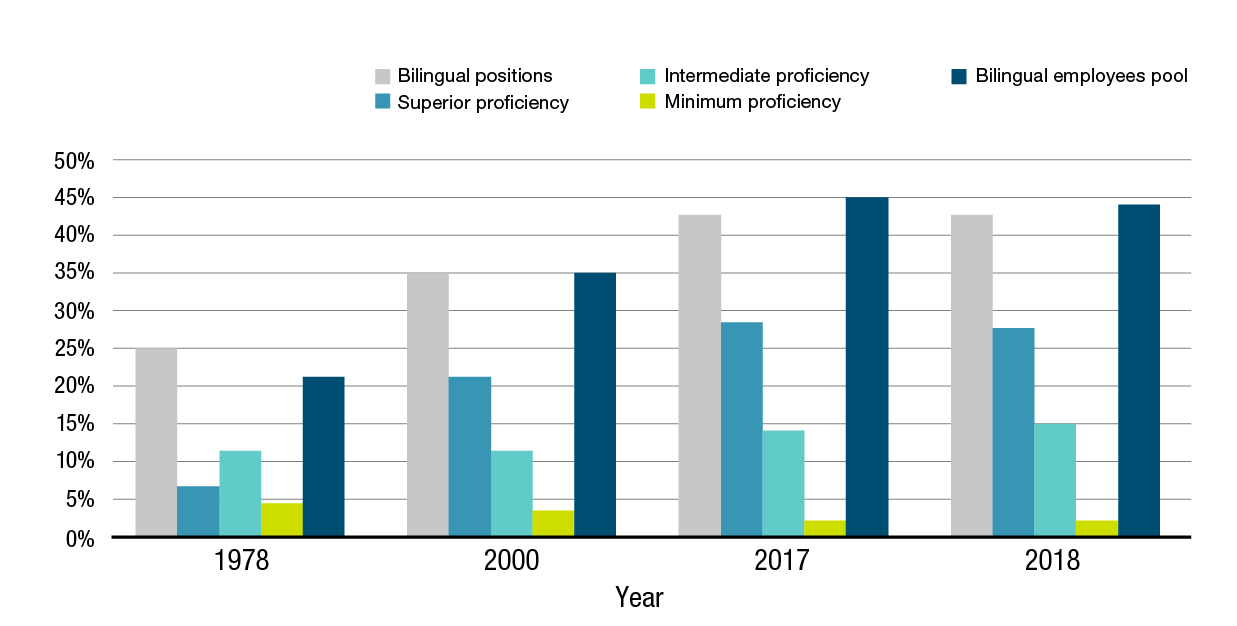
| Year | Bilingual positions | Superior proficiency | Intermediate proficiency | Minimum proficiency | Pool of bilingual employees |
|---|---|---|---|---|---|
| 1978 | 25% | 6% | 11% | 4% | 21% |
| 2000 | 35% | 21% | 11% | 3% | 35% |
| 2017 | 43% | 28% | 14% | 2% | 45% |
| 2018 | 43% | 27% | 15% | 2% | 44% |
Table 2
Language requirements of positions in the core public administration on March 31
In fiscal year 2017 to 2018, the number of bilingual positions in the core public administration increased by 5% over fiscal year 2016 to 2017. The number of bilingual positions as a percentage of the total number of positions, however, declined slightly (by 0.1%) from fiscal year 2016 to 2017 to fiscal year 2017 to 2018.
| Year | Bilingual positions | English essential positions | French essential positions | English or French essential positions | Incomplete records | Total positions | |||||
|---|---|---|---|---|---|---|---|---|---|---|---|
| 1978 | 52,300 | 24.7% | 128,196 | 60.5% | 17,260 | 8.1% | 14,129 | 6.7% | 0 | 0.0% | 211,885 |
| 2000 | 50,535 | 35.3% | 75,552 | 52.8% | 8,355 | 5.8% | 7,132 | 5.0% | 1,478 | 1.0% | 143,052 |
| 2017 | 77,889 | 43.0% | 90,838 | 50.1% | 6,443 | 3.6% | 5,888 | 3.3% | 82 | 0.0% | 181,140 |
| 2018 | 81,863 | 42.9% | 94,976 | 49.7% | 6,738 | 3.5% | 7,385 | 3.9% | 69 | 0.0% | 191,031 |
Table 3
Language requirements of positions in the core public administration, by province, territory or region on March 31
Of the 191,030 positions in the core public administration in fiscal year 2017 to 2018, 81,863 were bilingual. Most of the bilingual positions were in the National Capital Region (NCR) (66.4%), Quebec (excluding the NCR) (66.7%) and New Brunswick (50.5%).
| Province, territory or region | Bilingual positions | Unilingual positions | Incomplete records | Total positions | |||||||
|---|---|---|---|---|---|---|---|---|---|---|---|
| English essential | French essential | English or French essential | |||||||||
| British Columbia | 504 | 3.1% | 15,851 | 96.6% | 1 | 0.0% | 43 | 0.3% | 4 | 0.0% | 16,403 |
| Alberta | 386 | 3.9% | 9,382 | 95.7% | 2 | 0.0% | 27 | 0.3% | 5 | 0.1% | 9,802 |
| Saskatchewan | 132 | 2.9% | 4,457 | 96.9% | 0 | 0.0% | 11 | 0.2% | 0 | 0.0% | 4,600 |
| Manitoba | 521 | 8.0% | 5,988 | 91.7% | 0 | 0.0% | 16 | 0.2% | 2 | 0.0% | 6,527 |
| Ontario (excluding the NCR) | 2,587 | 10.7% | 21,331 | 88.6% | 10 | 0.0% | 153 | 0.6% | 7 | 0.0% | 24,088 |
| National Capital Region (NCR) | 57,283 | 66.4% | 22,024 | 25.5% | 150 | 0.2% | 6,800 | 7.9% | 28 | 0.0% | 86,285 |
| Quebec (excluding the NCR) | 13,626 | 66.7% | 147 | 0.7% | 6,477 | 31.7% | 175 | 0.9% | 16 | 0.1% | 20,441 |
| New Brunswick | 3,807 | 50.5% | 3,552 | 47.1% | 80 | 1.1% | 100 | 1.3% | 3 | 0.0% | 7,542 |
| Prince Edward Island | 474 | 27.3% | 1,254 | 72.3% | 1 | 0.1% | 5 | 0.3% | 0 | 0.0% | 1,734 |
| Nova Scotia | 926 | 11.4% | 7,104 | 87.8% | 17 | 0.2% | 40 | 0.5% | 4 | 0.0% | 8,091 |
| Newfoundland and Labrador | 93 | 3.0% | 2,960 | 96.6% | 0 | 0.0% | 12 | 0.4% | 0 | 0.0% | 3,065 |
| Yukon | 14 | 4.4% | 301 | 95.6% | 0 | 0.0% | 0 | 0.0% | 0 | 0.0% | 315 |
| Northwest Territories | 13 | 3.2% | 388 | 96.8% | 0 | 0.0% | 0 | 0.0% | 0 | 0.0% | 401 |
| Nunavut | 13 | 5.4% | 225 | 93.8% | 0 | 0.0% | 2 | 0.8% | 0 | 0.0% | 240 |
| Outside Canada | 1,484 | 99.1% | 12 | 0.8% | 0 | 0.0% | 1 | 0.1% | 0 | 0.0% | 1,497 |
| Total | 81,863 | 42.9% | 94,976 | 49.7% | 6,738 | 3.5% | 7,385 | 3.9% | 69 | 0.0% | 191,031 |
Table 4
Bilingual positions in the core public administration and linguistic status of incumbents on March 31
In fiscal year 2017 to 2018, the percentage of employees in bilingual positions in the core public administration who met the language requirements of their position declined slightly by 0.9% from fiscal year 2016 to 2017.
| Year | Employees meet requirements | Employees do not meet requirements | Incomplete records | Total employees | |||||
|---|---|---|---|---|---|---|---|---|---|
| Exempted | Must meet | ||||||||
| 1978 | 36,446 | 69.7% | 14,462 | 27.7% | 1,392 | 2.7% | 0 | 0.0% | 52,300 |
| 2000 | 41,832 | 82.8% | 5,030 | 10.0% | 968 | 1.9% | 2,705 | 5.4% | 50,535 |
| 2017 | 74,610 | 95.8% | 2,604 | 3.3% | 155 | 0.2% | 520 | 0.7% | 77,889 |
| 2018 | 77,668 | 94.9% | 2,926 | 3.6% | 112 | 0.1% | 1,157 | 1.4% | 81,863 |
Table 5
Bilingual positions in the core public administration and level of second language proficiency required (oral interaction) on March 31Footnote 19
The percentage of bilingual positions in the core public administration that require Level C proficiency for oral interaction remained stable from fiscal year 2016 to 2017 to fiscal year 2017 to 2018.
| Year | Level C | Level B | Level A | Other | Total positions | ||||
|---|---|---|---|---|---|---|---|---|---|
| 1978 | 3,771 | 7.2% | 30,983 | 59.2% | 13,816 | 26.4% | 3,730 | 7.1% | 52,300 |
| 2000 | 12,836 | 25.4% | 34,677 | 68.6% | 1,085 | 2.1% | 1,937 | 3.8% | 50,535 |
| 2017 | 27,457 | 35.3% | 48,794 | 62.7% | 347 | 0.5% | 1,291 | 1.7% | 77,889 |
| 2018 | 28,871 | 35.3% | 51,355 | 62.7% | 360 | 0.4% | 1,277 | 1.6% | 81,863 |
Table 6
Service to the public: Bilingual positions in the core public administration and linguistic status of incumbents on March 31
From fiscal year 2016 to 2017 to fiscal year 2017 to 2018, the percentage of employees in the core public administration who provide services to the public and who meet the language requirements of their position declined by 1.0%, and the percentage of incomplete records increased by 1.1%.
| Year | Employees meet requirements | Employees do not meet requirements | Incomplete records | Total employees | |||||
|---|---|---|---|---|---|---|---|---|---|
| Exempted | Must meet | ||||||||
| 1978 | 20,888 | 70.4% | 8,016 | 27.0% | 756 | 2.5% | 0 | 0.0% | 29,660 |
| 2000 | 26,766 | 82.3% | 3,429 | 10.5% | 690 | 2.1% | 1,631 | 5.0% | 32,516 |
| 2017 | 40,500 | 96.0% | 1,285 | 3.0% | 73 | 0.2% | 336 | 0.8% | 42,194 |
| 2018 | 41,227 | 95.0% | 1,315 | 3.0% | 45 | 0.1% | 830 | 1.9% | 43,417 |
Table 7
Service to the public: Bilingual positions in the core public administration and level of second language proficiency required (oral interaction) on March 31
Although the number of positions in the core public administration has increased since fiscal year 2016 to 2017, the percentage of bilingual positions offering services to the public and requiring Level C proficiency for oral interaction decreased slightly by 0.1% to 40.2% in fiscal year 2017 to 2018.
| Year | Level C | Level B | Level A | Other | Total positions | ||||
|---|---|---|---|---|---|---|---|---|---|
| 1978 | 2,491 | 8.4% | 19,353 | 65.2% | 7,201 | 24.3% | 615 | 2.1% | 29,660 |
| 2000 | 9,088 | 27.9% | 22,421 | 69.0% | 587 | 1.8% | 420 | 1.3% | 32,516 |
| 2017 | 16,989 | 40.3% | 25,027 | 59.3% | 105 | 0.2% | 73 | 0.2% | 42,194 |
| 2018 | 17,454 | 40.2% | 25,768 | 59.4% | 119 | 0.3% | 76 | 0.2% | 43,417 |
Table 8
Service to the public: Positions in the core public administration and linguistic status of incumbents, by province, territory or region on March 31
In fiscal year 2017 to 2018, of the 101,590 positions in the core public administration that provide services to the public, 43,417 provide services in both English and French. There were 41,227 incumbents in the 43,417 bilingual positions who met the language requirements of their positions.
| Province, territory or region | Bilingual positions | Unilingual positions | Total employees | |||||
|---|---|---|---|---|---|---|---|---|
| Employees meet requirements | Employees do not meet requirements | Incomplete records | English essential | French essential | English or French essential | |||
| Exempted | Must meet | |||||||
| Western and Northern Canada | 1,053 | 47 | 0 | 48 | 24,127 | 1 | 33 | 25,309 |
| Ontario (excluding the NCR) | 1,618 | 74 | 1 | 69 | 13,213 | 1 | 38 | 15,014 |
| National Capital Region (NCR) | 25,106 | 806 | 42 | 379 | 7,256 | 51 | 1,695 | 35,335 |
| Quebec (excluding the NCR) | 8,773 | 185 | 0 | 65 | 45 | 3,783 | 72 | 12,923 |
| New Brunswick | 2,722 | 97 | 0 | 11 | 2,294 | 77 | 10 | 5,211 |
| Other Atlantic provinces | 886 | 42 | 2 | 14 | 5,453 | 8 | 13 | 6,418 |
| Outside Canada | 1,069 | 64 | 0 | 244 | 3 | 0 | 0 | 1,380 |
| All regions | 41,227 | 1,315 | 45 | 830 | 52,391 | 3,921 | 1,861 | 101,590 |
Table 9
Personal and central services: Bilingual positions in the core public administration and linguistic status of incumbents on March 31
In fiscal year 2017 to 2018, 94.7% of the 58,134 incumbents who occupied positions in the core public administration that offer personal and central services met the linguistic requirements of their positions, which is a decrease of 1.0% from fiscal year 2016 to 2017.
| Year | Employees meet requirements | Employees do not meet requirements | Incomplete records | Total employees | |||||
|---|---|---|---|---|---|---|---|---|---|
| Exempted | Must meet | ||||||||
| 2016 | 52,797 | 95.6% | 1,966 | 3.6% | 83 | 0.2% | 389 | 0.7% | 55,235 |
| 2017 | 52,424 | 95.7% | 1,878 | 3.4% | 92 | 0.2% | 358 | 0.7% | 54,752 |
| 2018 | 55,025 | 94.7% | 2,100 | 3.6% | 57 | 0.1% | 952 | 1.6% | 58,134 |
Table 10
Personal and central services: Bilingual positions in the core public administration and level of second language proficiency required (oral interaction) on March 31
In fiscal year 2017 to 2018, 36.1% of the 58,134 positions in the core public administration that offer personal and central services required Level C proficiency in oral interaction, which is a decrease of 0.3% from fiscal year 2016 to 2017.
| Year | Level C | Level B | Level A | Other | Total positions | ||||
|---|---|---|---|---|---|---|---|---|---|
| 2016 | 19,437 | 35.2% | 34,671 | 62.8% | 197 | 0.4% | 930 | 1.7% | 55,235 |
| 2017 | 19,927 | 36.4% | 33,727 | 61.6% | 175 | 0.3% | 923 | 1.7% | 54,752 |
| 2018 | 20,972 | 36.1% | 36,044 | 62.0% | 190 | 0.3% | 928 | 1.6% | 58,134 |
Table 11
Supervision: Bilingual positions in the core public administration and linguistic status of incumbents on March 31
On March 31, 2018, 94.7% of incumbents in the core public administration’s 24,164 bilingual supervisory positions met the language requirements of their positions.
| Year | Employees meet requirements | Employees do not meet requirements | Incomplete records | Total employees | |||||
|---|---|---|---|---|---|---|---|---|---|
| Exempted | Must meet | ||||||||
| 2016 | 21,724 | 95.4% | 821 | 3.6% | 81 | 0.4% | 154 | 0.7% | 22,780 |
| 2017 | 22,122 | 95.4% | 838 | 3.6% | 104 | 0.4% | 119 | 0.5% | 23,183 |
| 2018 | 22,891 | 94.7% | 887 | 3.8% | 72 | 0.3% | 314 | 1.3% | 24,164 |
| Note: This table excludes employees working outside Canada. | |||||||||
Table 12
Supervision: Bilingual positions in the core public administration and level of second language proficiency required (oral interaction) on March 31
In fiscal year 2017 to 2018, 57.6% of the core public administration’s 24,164 bilingual supervisory positions required Level C proficiency in oral interaction, which is an increase of 1.4% over fiscal year 2016 to 2017.
| Year | Level C | Level B | Level A | Other | Total positions | ||||
|---|---|---|---|---|---|---|---|---|---|
| 2016 | 12,734 | 55.9% | 9,987 | 43.8% | 31 | 0.1% | 28 | 0.1% | 22,780 |
| 2017 | 13,026 | 56.2% | 10,099 | 43.6% | 29 | 0.1% | 29 | 0.1% | 23,183 |
| 2018 | 13,915 | 57.6% | 10,179 | 42.1% | 34 | 0.1% | 36 | 0.1% | 24,164 |
| Note: This table excludes employees working outside Canada. | |||||||||
Table 13
Participation of Anglophones and Francophones in the core public administration, by province, territory or region on March 31
On March 31, 2018, Newfoundland and Labrador had the highest percentage of Anglophones (98.5%) and Quebec (excluding the National Capital Region) had the highest percentage of Francophones (89.6%) working in the core public administration. These results are similar to those observed on March 31, 2017.
| Province, territory or region | Anglophones | Francophones | Unknown | Total employees | |||
|---|---|---|---|---|---|---|---|
| British Columbia | 16,098 | 98.1% | 305 | 1.9% | 0 | 0.0% | 16,403 |
| Alberta | 9,494 | 96.9% | 308 | 3.1% | 0 | 0.0% | 9,802 |
| Saskatchewan | 4,519 | 98.2% | 81 | 1.8% | 0 | 0.0% | 4,600 |
| Manitoba | 6,262 | 95.9% | 265 | 4.1% | 0 | 0.0% | 6,527 |
| Ontario (excluding the NCR) | 22,769 | 94.5% | 1,319 | 5.5% | 0 | 0.0% | 24,088 |
| National Capital Region (NCR) | 52,310 | 60.6% | 33,965 | 39.4% | 10 | 0.0% | 86,285 |
| Quebec (excluding the NCR) | 2,123 | 10.4% | 18,316 | 89.6% | 2 | 0.0% | 20,441 |
| New Brunswick | 4,283 | 56.8% | 3,259 | 43.2% | 0 | 0.0% | 7,542 |
| Prince Edward Island | 1,554 | 89.6% | 180 | 10.4% | 0 | 0.0% | 1,734 |
| Nova Scotia | 7,610 | 94.1% | 481 | 5.9% | 0 | 0.0% | 8,091 |
| Newfoundland and Labrador | 3,019 | 98.5% | 46 | 1.5% | 0 | 0.0% | 3,065 |
| Yukon | 305 | 96.8% | 10 | 3.2% | 0 | 0.0% | 315 |
| Northwest Territories | 379 | 94.5% | 22 | 5.5% | 0 | 0.0% | 401 |
| Nunavut | 212 | 88.3% | 28 | 11.7% | 0 | 0.0% | 240 |
| Outside Canada | 984 | 65.7% | 513 | 34.3% | 0 | 0.0% | 1,497 |
| All regions | 131,921 | 69.1% | 59,098 | 30.9% | 12 | 0.0% | 191,031 |
Table 14
Participation of Anglophones and Francophones in the core public administration, by occupational category on March 31
On March 31, 2018, the Operations category had the highest percentage of Anglophones (78.7%) and the Administration and Foreign Service category had the highest percentage of Francophones (37.9%) working in the core public administration. These results are similar to those observed on March 31, 2017.
| Category | Anglophones | Francophones | Unknown | Total employees | |||
|---|---|---|---|---|---|---|---|
| Management (EX) | 3,461 | 66.7% | 1,730 | 33.3% | 0 | 0.0% | 5,191 |
| Scientific and Professional | 26,736 | 75.4% | 8,697 | 24.5% | 6 | 0.0% | 35,439 |
| Administration and Foreign Service | 55,019 | 62.1% | 33,517 | 37.9% | 5 | 0.0% | 88,541 |
| Technical | 9,796 | 76.8% | 2,960 | 23.2% | 0 | 0.0% | 12,756 |
| Administrative Support | 14,206 | 70.2% | 6,034 | 29.8% | 1 | 0.0% | 20,241 |
| Operations | 22,702 | 78.7% | 6,160 | 21.3% | 0 | 0.0% | 28,862 |
| Unknown | 1 | 100.0% | 0 | 0.0% | 0 | 0.0% | 1 |
| All categories | 131,921 | 69.1% | 59,098 | 30.9% | 12 | 0.0% | 191,031 |
Table 15
Service to the public: Number of resources serving the public, by region or method of delivery, in bilingual offices in institutions not part of the core public administration on March 31Footnote 20
In fiscal year 2017 to 2018, 77,533 resources offered services to the public in the bilingual offices of federal institutions that are not part of the core public administration. Of these resources, 30,104 provided services in English and French.
| Province, territory or region | English only resources | French only resources | Bilingual resources | Total resources |
|---|---|---|---|---|
| Western and Northern Canada | 19,697 | 10 | 2,123 | 21,830 |
| Ontario (excluding the NCR) | 13,776 | 35 | 2,298 | 16,109 |
| National Capital Region (NCR) | 3,488 | 122 | 8,496 | 12,106 |
| Quebec (excluding the NCR) | 143 | 1,464 | 9,849 | 11,456 |
| New Brunswick | 505 | 15 | 1,370 | 1,890 |
| Other Atlantic provinces | 3,628 | 2 | 933 | 4,563 |
| Outside Canada | 24 | 0 | 35 | 59 |
| Travel | 4,038 | 0 | 3,917 | 7,955 |
| Telephone | 480 | 2 | 1,083 | 1,565 |
| Total | 45,779 | 1,650 | 30,104 | 77,533 |
Table 16
Participation of Anglophones and Francophones in institutions not part of the core public administration, by province, territory or region on March 31
On March 31, 2018, Newfoundland and Labrador had the highest percentage of Anglophones (97.9%) and Quebec (excluding the National Capital Region) had the highest percentage of Francophones (78.9%) working in institutions that are not part of the core public administration. These results are similar to those observed on March 31, 2017.
| Province, territory or region | Anglophones | Francophones | Unknown | Total resources | |||
|---|---|---|---|---|---|---|---|
| British Columbia | 35,222 | 96.1% | 1,427 | 3.9% | 6 | 0.0% | 36,655 |
| Alberta | 27,843 | 94.5% | 1,623 | 5.5% | 3 | 0.0% | 29,469 |
| Saskatchewan | 7,518 | 96.4% | 281 | 3.6% | 1 | 0.0% | 7,800 |
| Manitoba | 14,336 | 94.7% | 801 | 5.3% | 3 | 0.0% | 15,140 |
| Ontario (excluding the NCR) | 73,400 | 93.0% | 5,517 | 7.0% | 29 | 0.0% | 78,946 |
| National Capital Region (NCR) | 32,838 | 69.6% | 14,304 | 30.3% | 42 | 0.1% | 47,184 |
| Quebec (excluding the NCR) | 10,940 | 21.1% | 40,905 | 78.9% | 10 | 0.0% | 51,855 |
| New Brunswick | 7,764 | 72.4% | 2,967 | 27.6% | 0 | 0.0% | 10,731 |
| Prince Edward Island | 2,979 | 92.6% | 237 | 7.4% | 0 | 0.0% | 3,216 |
| Nova Scotia | 14,248 | 92.0% | 1,245 | 8.0% | 0 | 0.0% | 15,493 |
| Newfoundland and Labrador | 7,105 | 97.9% | 152 | 2.1% | 0 | 0.0% | 7,257 |
| Yukon | 372 | 91.4% | 35 | 8.6% | 0 | 0.0% | 407 |
| Northwest Territories | 581 | 87.0% | 87 | 13.0% | 0 | 0.0% | 668 |
| Nunavut | 277 | 86.8% | 42 | 13.2% | 0 | 0.0% | 319 |
| Outside Canada | 1,218 | 79.8% | 308 | 20.2% | 0 | 0.0% | 1,526 |
| All regions | 236,641 | 77.2% | 69,931 | 22.8% | 94 | 0.0% | 306,666 |
Table 17
Participation of Anglophones and Francophones in institutions not part of the core public administration, by occupational category or equivalent category on March 31Footnote 21
On March 31, 2018, the Operations category had the highest percentage of Anglophones (80.9%) and the Professionals category had the highest percentage of Francophones (27.0%) working in institutions that are not part of the core public administration. These results are similar to those observed on March 31, 2017.
| Category | Anglophones | Francophones | Unknown | Total resources | |||
|---|---|---|---|---|---|---|---|
| Management | 12,291 | 75.1% | 4,067 | 24.9% | 8 | 0.0% | 16,366 |
| Professionals | 29,361 | 72.9% | 10,877 | 27.0% | 14 | 0.0% | 40,252 |
| Specialists and Technicians | 17,159 | 75.1% | 5,688 | 24.9% | 5 | 0.0% | 22,852 |
| Administrative Support | 31,945 | 76.0% | 10,074 | 24.0% | 7 | 0.0% | 42,026 |
| Operations | 79,018 | 80.9% | 18,548 | 19.0% | 88 | 0.1% | 97,654 |
| Canadian Forces and Regular Members of the Royal Canadian Mounted Police | 63,078 | 75.7% | 20,236 | 24.3% | 0 | 0.0% | 83,314 |
| All categories | 232,852 | 77.0% | 69,490 | 23.0% | 122 | 0.0% | 302,464 |
Table 18
Participation of Anglophones and Francophones in all federal institutions subject to the Official Languages Act, by province, territory or region on March 31
In fiscal year 2017 to 2018, Newfoundland and Labrador had the highest percentage of Anglophones (98.1%) and Quebec (excluding the National Capital Region) had the highest percentage of Francophones (81.9%) working in all institutions subject to the Official Languages Act. These results are similar to those for fiscal year 2016 to 2017.
| Province, territory or region | Anglophones | Francophones | Unknown | Total | |||
|---|---|---|---|---|---|---|---|
| British Columbia | 51,320 | 96.7% | 1,732 | 3.3% | 6 | 0.0% | 53,058 |
| Alberta | 37,337 | 95.1% | 1,931 | 4.9% | 3 | 0.0% | 39,271 |
| Saskatchewan | 12,037 | 97.1% | 362 | 2.9% | 1 | 0.0% | 12,400 |
| Manitoba | 20,598 | 95.1% | 1,066 | 4.9% | 3 | 0.0% | 21,667 |
| Ontario (excluding the NCR) | 96,169 | 93.3% | 6,836 | 6.6% | 29 | 0.0% | 103,034 |
| National Capital Region (NCR) | 85,148 | 63.8% | 48,269 | 36.2% | 52 | 0.1% | 133,469 |
| Quebec (excluding the NCR) | 13,063 | 18.1% | 59,221 | 81.9% | 12 | 0.0% | 72,296 |
| New Brunswick | 12,047 | 65.9% | 6,226 | 34.1% | 0 | 0.0% | 18,273 |
| Prince Edward Island | 4,533 | 91.6% | 417 | 8.4% | 0 | 0.0% | 4,950 |
| Nova Scotia | 21,858 | 92.7% | 1,726 | 7.3% | 0 | 0.0% | 23,584 |
| Newfoundland and Labrador | 10,124 | 98.1% | 198 | 1.9% | 0 | 0.0% | 10,322 |
| Yukon | 677 | 93.8% | 45 | 6.2% | 0 | 0.0% | 722 |
| Northwest Territories | 960 | 89.8% | 109 | 10.2% | 0 | 0.0% | 1,069 |
| Nunavut | 489 | 87.5% | 70 | 12.5% | 0 | 0.0% | 559 |
| Outside Canada | 2,202 | 72.8% | 821 | 27.2% | 0 | 0.0% | 3,023 |
| All regions | 368,562 | 74.0% | 129,029 | 25.9% | 106 | 0.0% | 497,697 |
© Her Majesty the Queen in Right of Canada, represented by the President of the Treasury Board, 2019,
Catalogue No.BT23-1E-PDF, ISSN: 1486-9683
Page details
- Date modified:
